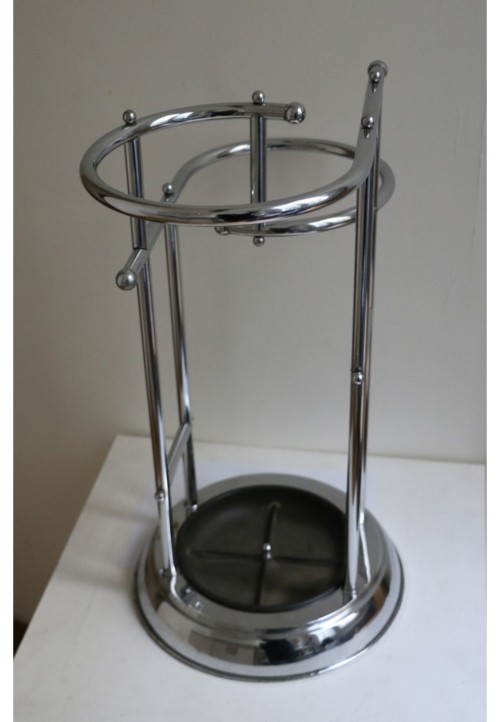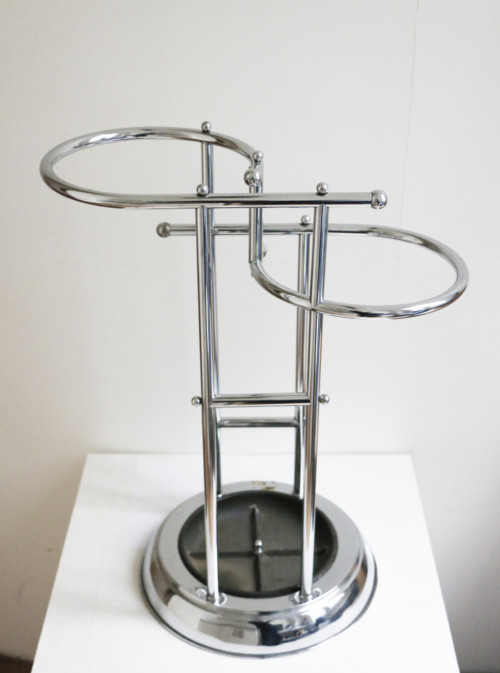-
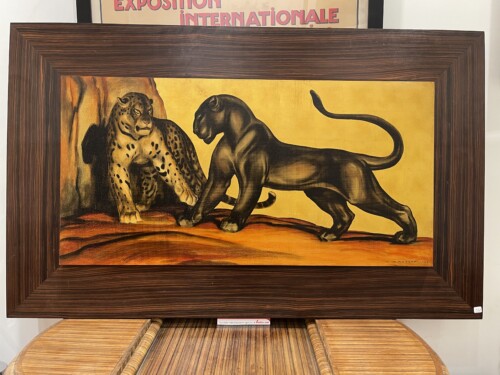
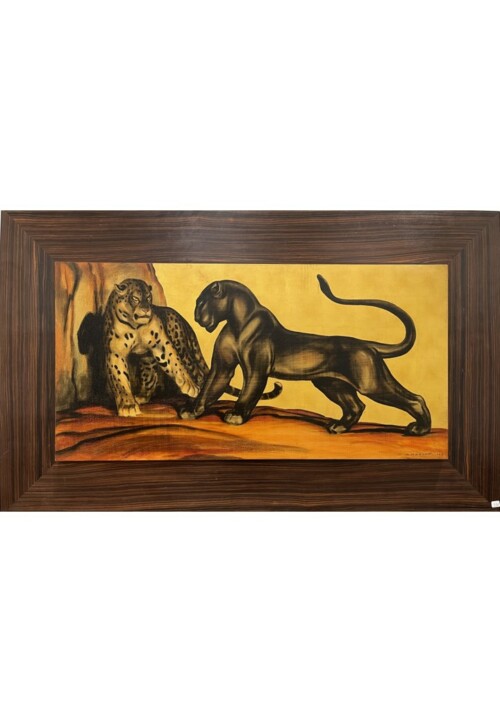 Exceptionnelle laque sur fond d’or représentant deux félins par André Margat. André Margat est un artiste français, largement connu pour ses représentations animalières. Il appartient notamment au “Groupe des Douze”, une association d’artistes créée en 1932 dont le but est de présenter l’art animalier français lors d’expositions et de chaque année mettre à l’honneur un artiste. Cette œuvre est réalisée en laque peinte sur fond or, une technique complexe qui marque la virtuosité de l’artiste. Par ailleurs, cette œuvre témoigne d’un travail poussé d’observation de la nature. L’artiste parvient à retranscrire les comportements des félins avec une grande justesse et apporte un sentiment de mouvement et de dynamisme témoignant d’une étude anatomique et comportementale aboutie. Les félins sont dépeints dans un fond rocailleux simple qui permet d’inscrire les animaux dans une spatialité définie. Le ciel doré vient apporter de la lumière, mais aussi permet au spectateur de se concentrer sur l’essence même du tableau, les félins. Le tableau est signé et daté de 1942 en bas à droite, et est accompagné d’un cadre en placage d'ébène de Macassar. Dimensions : 50 x 100 cm (cadre : 80 x 130 cm) Pour découvrir André Margat, cliquez ici
Exceptionnelle laque sur fond d’or représentant deux félins par André Margat. André Margat est un artiste français, largement connu pour ses représentations animalières. Il appartient notamment au “Groupe des Douze”, une association d’artistes créée en 1932 dont le but est de présenter l’art animalier français lors d’expositions et de chaque année mettre à l’honneur un artiste. Cette œuvre est réalisée en laque peinte sur fond or, une technique complexe qui marque la virtuosité de l’artiste. Par ailleurs, cette œuvre témoigne d’un travail poussé d’observation de la nature. L’artiste parvient à retranscrire les comportements des félins avec une grande justesse et apporte un sentiment de mouvement et de dynamisme témoignant d’une étude anatomique et comportementale aboutie. Les félins sont dépeints dans un fond rocailleux simple qui permet d’inscrire les animaux dans une spatialité définie. Le ciel doré vient apporter de la lumière, mais aussi permet au spectateur de se concentrer sur l’essence même du tableau, les félins. Le tableau est signé et daté de 1942 en bas à droite, et est accompagné d’un cadre en placage d'ébène de Macassar. Dimensions : 50 x 100 cm (cadre : 80 x 130 cm) Pour découvrir André Margat, cliquez ici
Exceptional lacquer on a gold background depicting two felines by André Margat. André Margat is a French artist widely known for his representations of animals. He is a member of the 'Groupe des Douze,' an association of artists created in 1932 with the aim of presenting French animal art in exhibitions and honoring an artist each year. This artwork is created using painted lacquer on a gold background, a complex technique that showcases the artist's virtuosity. Additionally, this piece reflects a detailed observation of nature. The artist skillfully captures the behaviors of the felines with great accuracy, bringing a sense of movement and dynamism that attests to a thorough anatomical and behavioral study. The felines are depicted against a simple rocky background, providing a defined spatial context. The golden sky adds light and allows the viewer to focus on the essence of the painting—the felines. The artwork is signed and dated 1942 at the bottom right and comes with a Macassar ebony veneer frame. Dimensions: 50 x 100 cm (frame: 80 x 130 cm). To discover André Margat, please click here -
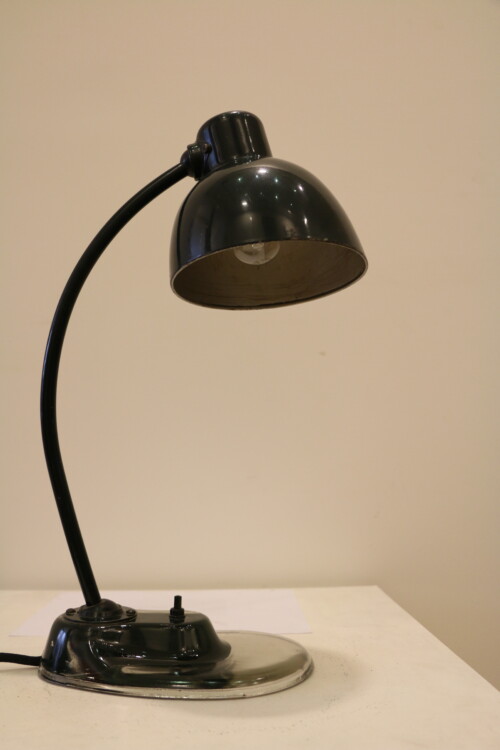
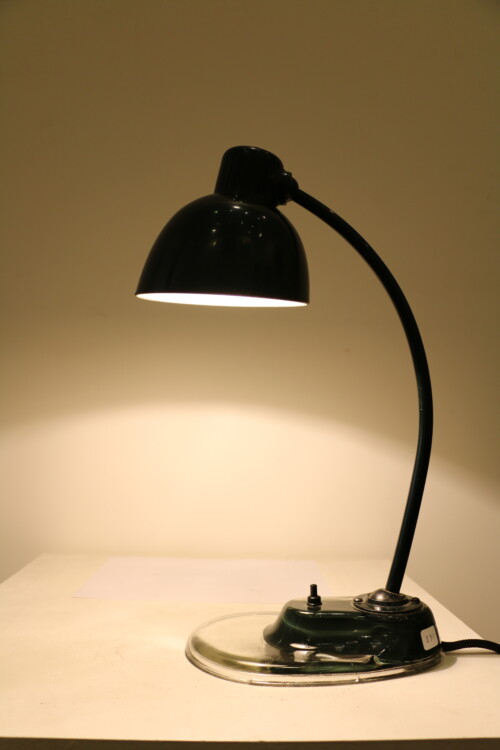 Marianne Brandt Lampe Bauhaus Métal, verre Emblématique lampe de bureau Bauhaus par Marianne Brandt (1893-1983), fabriquée par Kandem. Ce type de base en verre réalisé dans ce modèle, est le plus recherché. Peinture d'origine verte foncée. Fonctionnelle. Cable à utilisation européenne. H : 46 cm ; L : 25 cm ; P : 22 cm Pour plus d'informations sur la créatrice, cliquer sur le nom : Marianne BRANDT
Marianne Brandt Lampe Bauhaus Métal, verre Emblématique lampe de bureau Bauhaus par Marianne Brandt (1893-1983), fabriquée par Kandem. Ce type de base en verre réalisé dans ce modèle, est le plus recherché. Peinture d'origine verte foncée. Fonctionnelle. Cable à utilisation européenne. H : 46 cm ; L : 25 cm ; P : 22 cm Pour plus d'informations sur la créatrice, cliquer sur le nom : Marianne BRANDT
Bauhaus lamp Emblematic Bauhaus desk lamp designed by Marianne Brandt (1893 - 1983) and manufactured by Kandem. It has the typical glass base which makes this model the much sought after one. Original dark green paint. Fully functional. Wired for European use. H : 46 cm ; W : 25 cm ; D : 22 cm For more informations : Marianne BRANDT -
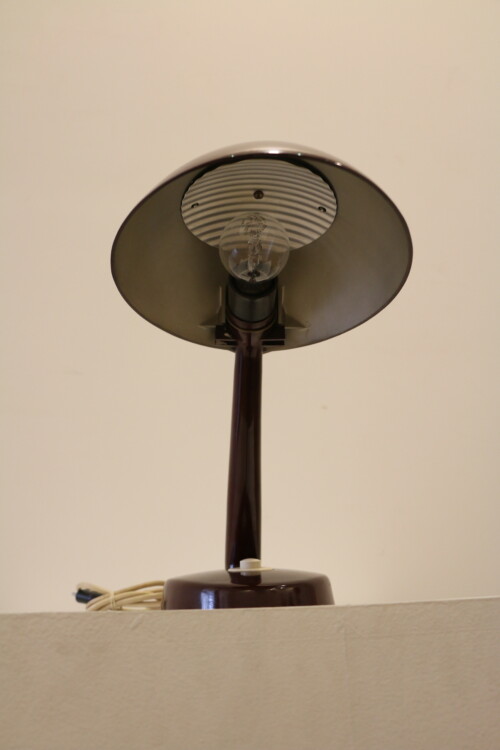
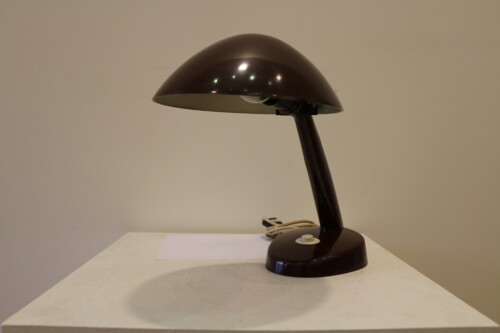 Marianne Brandt Lampe en bakélite rouge Bakélite Emblématique lampe de bureau Bahaus par Marianne Brandt (1893-1983) et fabriqué par Kandem. Ce type de base en verre réalisé dans ce modèle, est le plus recherché. Peinture verte foncée originale. Fonctionnelle. Cable à utilisation européenne. H : 32 cm ; L : 22 cm ; P : 40 cm Pour plus d'informations sur la créatrice, cliquer sur le nom : Marianne BRANDT
Marianne Brandt Lampe en bakélite rouge Bakélite Emblématique lampe de bureau Bahaus par Marianne Brandt (1893-1983) et fabriqué par Kandem. Ce type de base en verre réalisé dans ce modèle, est le plus recherché. Peinture verte foncée originale. Fonctionnelle. Cable à utilisation européenne. H : 32 cm ; L : 22 cm ; P : 40 cm Pour plus d'informations sur la créatrice, cliquer sur le nom : Marianne BRANDT
Bahaus lamp Emblematic Bauhaus desk lamp designed by Marianne Brandt (1893 - 1983) and manufactured by Kandem. It has the typical glass base which makes this model the much sought after one. Original dark green paint. Fully functional. Wired for European use. H : 46 cm ; W : 25 cm ; D : 22 cm For more informations : Marianne BRANDT -
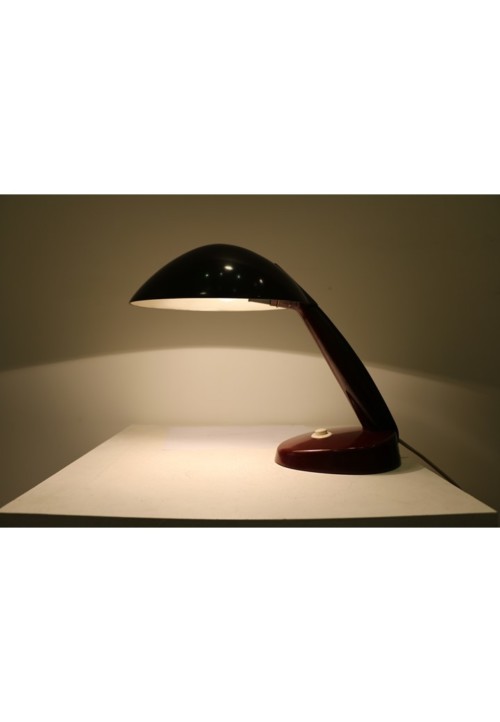
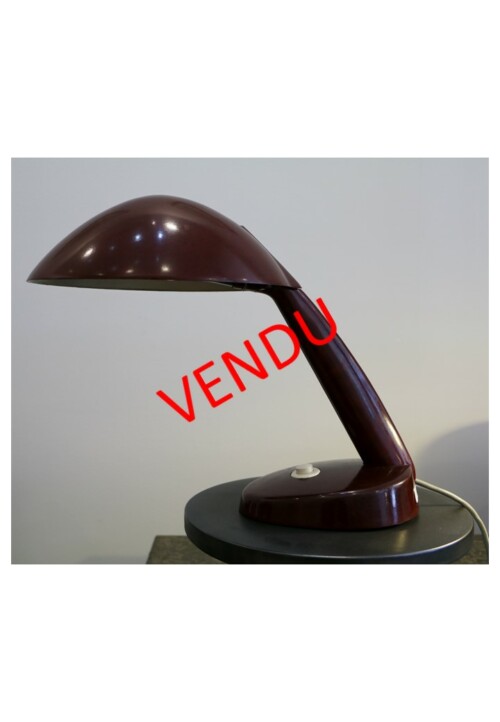 Attribuée à Marianne BRANDT (1893-1983) Lampe Kandem Vers 1945 Couleur rouge bordeaux H : 32 cm ; L : 22 cm ; P : 40 cm Pour plus d'informations sur la créatrice, cliquer sur le nom : Marianne BRANDT
Attribuée à Marianne BRANDT (1893-1983) Lampe Kandem Vers 1945 Couleur rouge bordeaux H : 32 cm ; L : 22 cm ; P : 40 cm Pour plus d'informations sur la créatrice, cliquer sur le nom : Marianne BRANDT
Rare Kandem bakelite table lamp attributed to Marianne Brandt, circa 1945.Kandem (Körting & Mathiesen) edition bakelite table lamp attributed to Marianne Brandt.
Marianne Brandt worked for the lamp editor Kandem for whom she designed the most representative models in a tight cooperation between the Bauhaus and Kandem. When the Bauhaus was forbidden she continued to work as a free lancer.
This bakelite table lamp is approximately dated 1945. Wired for European use.Dimensions :H : 12.6 in. ; W : 8.66 in. ; D : 15.75 in.H : 32 cm ; W : 22 cm ; D : 40 cm -
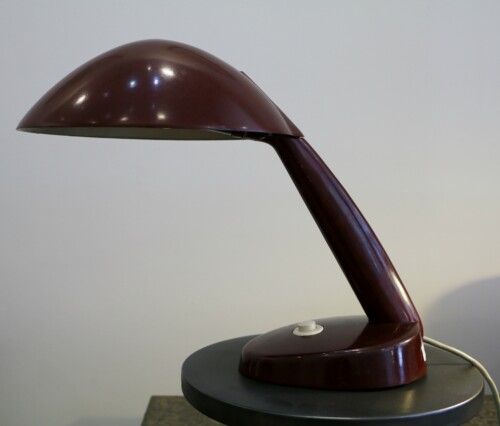
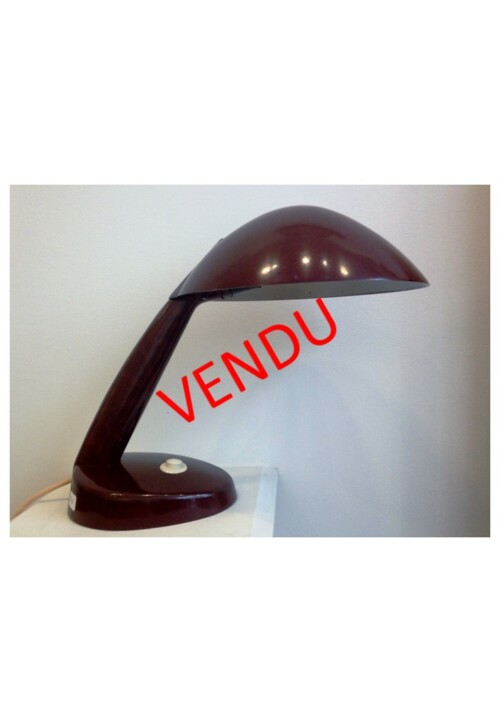 Attribuée à Marianne BRANDT (1893-1983) Lampe Kandem Années 1940 Couleur rouge bordeaux H : 32 cm ; L : 22 cm ; P : 40 cm Pour plus d'informations sur la créatrice, cliquer sur le nom : Marianne BRANDT
Attribuée à Marianne BRANDT (1893-1983) Lampe Kandem Années 1940 Couleur rouge bordeaux H : 32 cm ; L : 22 cm ; P : 40 cm Pour plus d'informations sur la créatrice, cliquer sur le nom : Marianne BRANDT
Rare Kandem bakelite table lamp attributed to Marianne Brandt, circa 1945.Kandem (Körting & Mathiesen) edition bakelite table lamp attributed to Marianne Brandt.
Marianne Brandt worked for the lamp editor Kandem for whom she designed the most representative models in a tight cooperation between the Bauhaus and Kandem. When the Bauhaus was forbidden she continued to work as a free lancer.
This bakelite table lamp is approximately dated 1945. Wired for European use.Dimensions :H : 12.6 in. ; W : 8.66 in. ; D : 15.75 in.H : 32 cm ; W : 22 cm ; D : 40 cm -
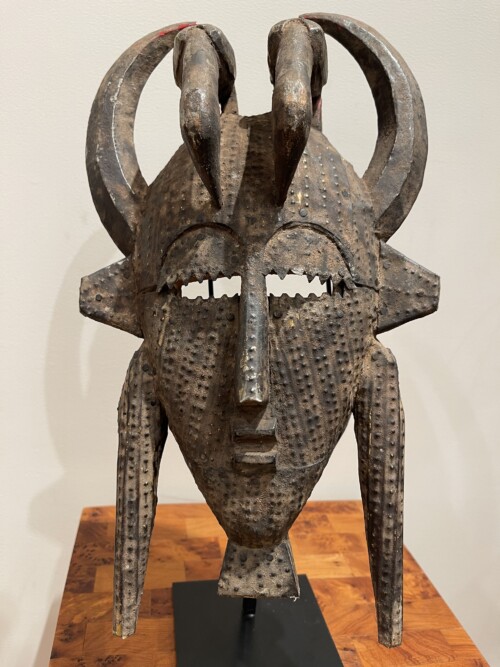
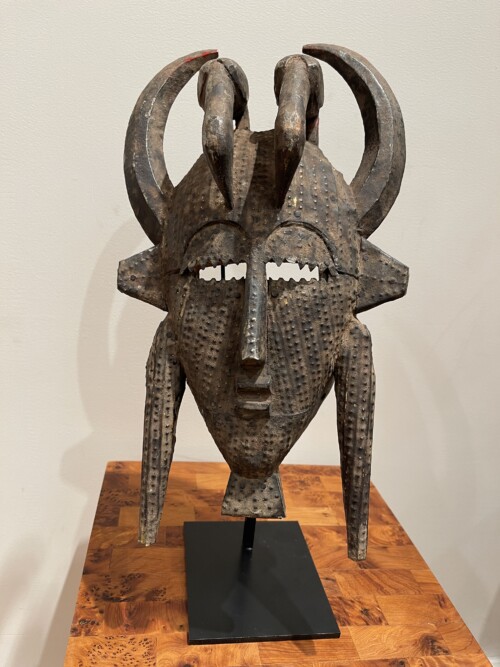 Masque Kpélié culture Sénoufo, Côte d’Ivoire Bois recouvert de plaques de cuivre, surmonté d’un couple de deux Calao, circa 1950 Dimensions : H : 36.5 cm L : 14.5 cm Les populations de langue Sénoufo se répartissent sur un large territoire allant du sud du Mali, sud Burkina Faso au nord de la Côte d’Ivoire. On compte aujourd’hui une trentaine de sous-groupes différents. Les Sénoufo possèdent une structure religieuse riche en symboles et rites liée à une organisation initiatique reposant sur les classes d'âges masculines, le poro. En effet, la vie des hommes est rythmée par des étapes dont une initiation pour passer du garçon à l’homme. La société initiatique Lô est la plus importante et s’occupe de l’initiation des jeunes garçons. Les jeunes garçons apprennent leur rôle, la généalogie, la religion, les enjeux sociaux et une langue spéciale. Les initiations se font dans des espaces éloignés du village, en secret, dans les bois sacrés. Cette initiation est très longue et peut durer dans certains cas pendant trois phases de sept ans. Les objets sont alors confectionnés par des sculpteurs professionnels capables de contrôler la force spirituelle contenus dans les matériaux. A la fin de ces étapes initiatiques, l’initié fait partie des hommes qui savent, des sages. Le masque Kpélié a une place spécifique, il est utilisé lors des cérémonies initiatiques de la société Lô, lors de funérailles et pendant les cérémonies de récoltes. Les masques Sénoufo ont de nombreuses appellations dont kpélié, kodelié, ou kulié. Kulié est un terme qui dériverait de ku = la mort et ié = le visage, ce qui pourrait indiquer que le masque est associé à un ancêtre. En effet, le culte des ancêtres est majeur pour ces populations. Les masques Sénoufo présentent des formes caractéristiques qui permettent de les identifier. Le visage est ovale, le nez long, une petite bouche qui dans certaines régions peut montrer ses dents, le menton est long et anguleux. Autour du visage, viennent s’ajouter des éléments périphériques notamment des éléments frontaux figuratifs souvent associés à un des cinq animaux mythologiques, chacun ancêtre d’un clan. Notre masque présente deux oiseaux, qui pourraient représenter le calao, l’oiseau mythologique associé à la notion de procréation et ancêtre du clan des forgerons. Ainsi la présence de l’oiseau permettrait de limiter l’utilisation du masque à ce même clan. Les oiseaux sont cernés de part et d'autre de cornes de bélier, caractéristique de ces masques sans qu’on puisse en définir l’origine symbolique. Au niveau des joues, on remarque des semi ellipses ou triangles et en partie inférieure ce qui ressemble à des jambes. Les masques marquent tous un travail de symétrie et d’équilibre des formes fortement symbolique. L’interprétation précise de l’utilisation de ces masques diffère, Albert Maesen avance que ces masques sont utilisés lors des deux premières phases de l’initiation, et qu’ils évoquent la peur. Bohumil Holas quant à lui trouve une explication métaphysique et présente un lien avec la spiritualité et la méditation qui serait accessible seulement aux initiés supérieurs, le masque rappellerait alors l’imperfection et la précarité de la condition humaine. Certains masques comme le nôtre présentent du métal appliqué sur le bois sous forme de bandes fixées par des clous à tête ronde. Cette spécificité ressemble aux objets que l’on peut trouver chez les Bamana et les Marka. La fonction de ces masques en métal reste floue quant à leur utilisation lors de cérémonies religieuses.
Masque Kpélié culture Sénoufo, Côte d’Ivoire Bois recouvert de plaques de cuivre, surmonté d’un couple de deux Calao, circa 1950 Dimensions : H : 36.5 cm L : 14.5 cm Les populations de langue Sénoufo se répartissent sur un large territoire allant du sud du Mali, sud Burkina Faso au nord de la Côte d’Ivoire. On compte aujourd’hui une trentaine de sous-groupes différents. Les Sénoufo possèdent une structure religieuse riche en symboles et rites liée à une organisation initiatique reposant sur les classes d'âges masculines, le poro. En effet, la vie des hommes est rythmée par des étapes dont une initiation pour passer du garçon à l’homme. La société initiatique Lô est la plus importante et s’occupe de l’initiation des jeunes garçons. Les jeunes garçons apprennent leur rôle, la généalogie, la religion, les enjeux sociaux et une langue spéciale. Les initiations se font dans des espaces éloignés du village, en secret, dans les bois sacrés. Cette initiation est très longue et peut durer dans certains cas pendant trois phases de sept ans. Les objets sont alors confectionnés par des sculpteurs professionnels capables de contrôler la force spirituelle contenus dans les matériaux. A la fin de ces étapes initiatiques, l’initié fait partie des hommes qui savent, des sages. Le masque Kpélié a une place spécifique, il est utilisé lors des cérémonies initiatiques de la société Lô, lors de funérailles et pendant les cérémonies de récoltes. Les masques Sénoufo ont de nombreuses appellations dont kpélié, kodelié, ou kulié. Kulié est un terme qui dériverait de ku = la mort et ié = le visage, ce qui pourrait indiquer que le masque est associé à un ancêtre. En effet, le culte des ancêtres est majeur pour ces populations. Les masques Sénoufo présentent des formes caractéristiques qui permettent de les identifier. Le visage est ovale, le nez long, une petite bouche qui dans certaines régions peut montrer ses dents, le menton est long et anguleux. Autour du visage, viennent s’ajouter des éléments périphériques notamment des éléments frontaux figuratifs souvent associés à un des cinq animaux mythologiques, chacun ancêtre d’un clan. Notre masque présente deux oiseaux, qui pourraient représenter le calao, l’oiseau mythologique associé à la notion de procréation et ancêtre du clan des forgerons. Ainsi la présence de l’oiseau permettrait de limiter l’utilisation du masque à ce même clan. Les oiseaux sont cernés de part et d'autre de cornes de bélier, caractéristique de ces masques sans qu’on puisse en définir l’origine symbolique. Au niveau des joues, on remarque des semi ellipses ou triangles et en partie inférieure ce qui ressemble à des jambes. Les masques marquent tous un travail de symétrie et d’équilibre des formes fortement symbolique. L’interprétation précise de l’utilisation de ces masques diffère, Albert Maesen avance que ces masques sont utilisés lors des deux premières phases de l’initiation, et qu’ils évoquent la peur. Bohumil Holas quant à lui trouve une explication métaphysique et présente un lien avec la spiritualité et la méditation qui serait accessible seulement aux initiés supérieurs, le masque rappellerait alors l’imperfection et la précarité de la condition humaine. Certains masques comme le nôtre présentent du métal appliqué sur le bois sous forme de bandes fixées par des clous à tête ronde. Cette spécificité ressemble aux objets que l’on peut trouver chez les Bamana et les Marka. La fonction de ces masques en métal reste floue quant à leur utilisation lors de cérémonies religieuses.
Splendid Kpélié Mask, Sénoufo population, Ivory Coast 1950 Kpélié Mask, wood covered with copper Dimensions 36.5 x 14.5 cm / 14.17 x 5.51 inches The populations speaking the Sénoufo language are spread across a vast territory ranging from southern Mali, southern Burkina Faso to northern Ivory Coast. Today, there are around thirty different subgroups. The Sénoufo people possess a rich religious structure rich in symbols and rites linked to an initiatory organization based on male age classes, known as "poro". Indeed, men's lives are punctuated by stages, including an initiation to transition from boyhood to manhood. The initiatory society "Lô" is the most important and handles the initiation of young boys. Young boys learn about their role, genealogy, religion, social issues, and a special language. Initiations take place in areas far from the village, in secret, in sacred groves. This initiation is very lengthy and can last for three phases of seven years in some cases. Objects are crafted by professional sculptors capable of controlling the spiritual force contained within the materials. At the end of these initiation stages, the initiate becomes one of the knowledgeable men, one of the wise. The Kpélié mask holds a specific place; it is used during the initiatory ceremonies of the Lô society, during funerals, and during harvest ceremonies. Sénoufo masks have various names including kpélié, kodelié, or kulié. "Kulié" is a term that may derive from "ku" meaning death and "ié" meaning face, which could indicate that the mask is associated with an ancestor. Indeed, ancestor worship is significant for these populations. Sénoufo masks exhibit characteristic forms that allow for their identification. The face is oval, the nose long, with a small mouth that in some regions may show teeth, and a long, angular chin. Around the face, additional peripheral elements are added, including figurative frontal elements often associated with one of the five mythological animals, each ancestor of a clan. Our mask features two birds, which could represent the hornbill, the mythological bird associated with the notion of procreation and ancestor of the blacksmith clan. Thus, the presence of the bird would limit the use of the mask to this same clan. The birds are surrounded on both sides by ram horns, a characteristic of these masks, without a clear symbolic origin. On the cheeks, semi-ellipses or triangles are noticeable, and on the lower part, what appears to be legs. All masks exhibit a work of symmetry and balance of forms, highly symbolic. The precise interpretation of the use of these masks differs; Albert Maesen suggests that these masks are used during the first two phases of initiation, evoking fear. Bohumil Holas, on the other hand, finds a metaphysical explanation and presents a link with spirituality and meditation accessible only to higher initiates, suggesting that the mask then recalls the imperfection and precariousness of human condition. Some masks, like our, feature metal applied to wood in the form of strips fixed with round-headed nails. This specificity resembles objects found among the Bamana and Marka. The function of these metal masks remains unclear regarding their use in religious ceremonies. -
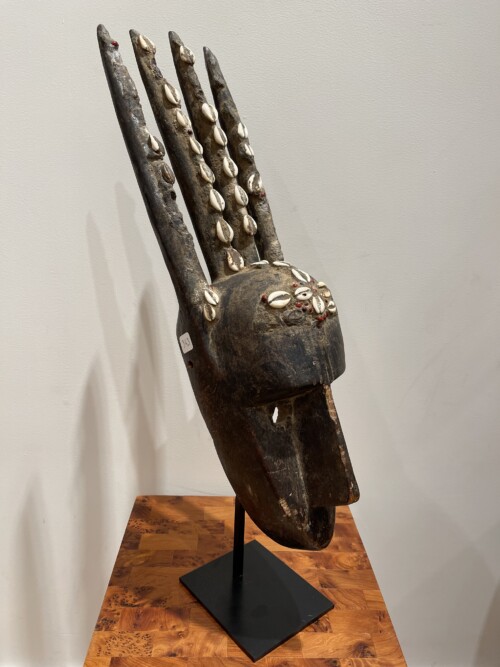
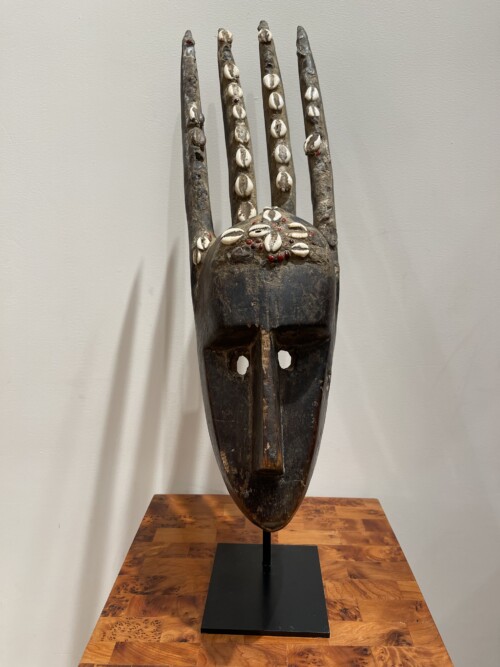 Masque « Ntomo », population Bamana, Mali Masque à peigne à quatre dents, bois recouvert de cauris, patine ancienne. Dimensions : H : 52 cm L : 14.5 cm Le masque Ntomo, est associé à un rituel d’initiation des jeunes hommes non circoncis des sociétés d’Afrique de l’Ouest. Ce type de masque est identifiable grâce à sa partie supérieure en forme de peigne de trois à huit cornes. On appelle Bamana les populations du Mali, Nord-Est de la Guinée et Nord de la Côte d’Ivoire, partageant un mode de vie commun et une langue similaire, la langue mandingue. Les Bamana ont une histoire qui remonte à l’Empire du Ghana au IIIe siècle, puis à l’Empire du Mali au XIIIe. On rencontre d’autres appellations de cette population, comme Bambara, qui est utilisée au XIIIe pour désigner ces peuples on convertis à l’islam, bamabara voulant dire “infidèles”. La vie d’un homme issu de cette population est rythmée en étapes codifiées. Un jeune garçon doit passer un rituel initiatique et éducatif dirigé par une société pour devenir un homme. Cette société initiatique forme les jeunes de 6 à 13 ans. Chaque promotion suit une formation secrète de trois à cinq ans. Les enseignements portent sur des questions métaphysiques, sur la maîtrise de soi, la place de l’homme, l'humilité, le respect. D’autres épreuves complètent l'enseignement comme l’apport de vivres, par l'aumône, le travail agricole, la chasse et la pêche. C’est lors de la fête annuelle que les jeunes faisaient des épreuves corporelles de flagellation munis d’un fouet et d’un masque Ntomo. Ces initiations étaient contrôlées par les forgerons, les seuls à pouvoir confectionner ces masques sacrés. En effet, le bois est réputé comme réceptacle du nyama, une énergie dangereuse que seuls les forgerons peuvent maîtriser grâce à leurs savoirs. La confection du masque est rituelle et soumise à des conditions. Avant de sculpter, le forgeron communique avec un génie, le djinn, qui lui indique la localisation de l'arbre à abattre, sa forme et son essence. Le forgeron est soumis à des interdits comme l’abstinence, il doit sculpter seul, loin du village. Les masques, une fois sculptés, bénéficient d’une grande force spirituelle. Ntomo désigne en Bamana “jujubier”, l’arbre sur lequel étaient offerts les sacrifices. Ntomadyiri, (l’arbre du Ntomo) est considéré comme l’ancêtre des forgerons et le créateur de la société Ntomo, il serait le premier à avoir sculpté un masque. Par ailleurs, il ne faut pas envisager le masque comme un objet individuel, il est associé à un costume, à un fouet et fait partie d’un rituel. Le masque ressemble à un être cornu, griffu que l’on ne peut définir, faisant référence à des animaux stylisés. La bouche est discrète, le nez proéminent. La bouche fine, parfois absente dans les masques les plus anciens, est associée au contrôle de la parole et des actes, à la préservation des secrets et à la force face à la douleur. Le nombre de cornes est symbolique et riche de sens, il indique non pas le genre du porteur qui est un jeune garçon, mais le genre du masque. Ainsi les masques à trois ou six cornes est masculin, à quatre ou huit cornes est féminin et à deux, cinq ou sept cornes est androgyne. Notre masque possède quatre dents, est est donc associé au genre féminin. Les masques de genre féminins révèlent selon Dominique Zhan “la nature corporelle de l’homme, sa féminité, passivité et souffrance”. Un autre masque Bamana est présenté à la vente, il possède sept dents, associé à l'androgynie.
Masque « Ntomo », population Bamana, Mali Masque à peigne à quatre dents, bois recouvert de cauris, patine ancienne. Dimensions : H : 52 cm L : 14.5 cm Le masque Ntomo, est associé à un rituel d’initiation des jeunes hommes non circoncis des sociétés d’Afrique de l’Ouest. Ce type de masque est identifiable grâce à sa partie supérieure en forme de peigne de trois à huit cornes. On appelle Bamana les populations du Mali, Nord-Est de la Guinée et Nord de la Côte d’Ivoire, partageant un mode de vie commun et une langue similaire, la langue mandingue. Les Bamana ont une histoire qui remonte à l’Empire du Ghana au IIIe siècle, puis à l’Empire du Mali au XIIIe. On rencontre d’autres appellations de cette population, comme Bambara, qui est utilisée au XIIIe pour désigner ces peuples on convertis à l’islam, bamabara voulant dire “infidèles”. La vie d’un homme issu de cette population est rythmée en étapes codifiées. Un jeune garçon doit passer un rituel initiatique et éducatif dirigé par une société pour devenir un homme. Cette société initiatique forme les jeunes de 6 à 13 ans. Chaque promotion suit une formation secrète de trois à cinq ans. Les enseignements portent sur des questions métaphysiques, sur la maîtrise de soi, la place de l’homme, l'humilité, le respect. D’autres épreuves complètent l'enseignement comme l’apport de vivres, par l'aumône, le travail agricole, la chasse et la pêche. C’est lors de la fête annuelle que les jeunes faisaient des épreuves corporelles de flagellation munis d’un fouet et d’un masque Ntomo. Ces initiations étaient contrôlées par les forgerons, les seuls à pouvoir confectionner ces masques sacrés. En effet, le bois est réputé comme réceptacle du nyama, une énergie dangereuse que seuls les forgerons peuvent maîtriser grâce à leurs savoirs. La confection du masque est rituelle et soumise à des conditions. Avant de sculpter, le forgeron communique avec un génie, le djinn, qui lui indique la localisation de l'arbre à abattre, sa forme et son essence. Le forgeron est soumis à des interdits comme l’abstinence, il doit sculpter seul, loin du village. Les masques, une fois sculptés, bénéficient d’une grande force spirituelle. Ntomo désigne en Bamana “jujubier”, l’arbre sur lequel étaient offerts les sacrifices. Ntomadyiri, (l’arbre du Ntomo) est considéré comme l’ancêtre des forgerons et le créateur de la société Ntomo, il serait le premier à avoir sculpté un masque. Par ailleurs, il ne faut pas envisager le masque comme un objet individuel, il est associé à un costume, à un fouet et fait partie d’un rituel. Le masque ressemble à un être cornu, griffu que l’on ne peut définir, faisant référence à des animaux stylisés. La bouche est discrète, le nez proéminent. La bouche fine, parfois absente dans les masques les plus anciens, est associée au contrôle de la parole et des actes, à la préservation des secrets et à la force face à la douleur. Le nombre de cornes est symbolique et riche de sens, il indique non pas le genre du porteur qui est un jeune garçon, mais le genre du masque. Ainsi les masques à trois ou six cornes est masculin, à quatre ou huit cornes est féminin et à deux, cinq ou sept cornes est androgyne. Notre masque possède quatre dents, est est donc associé au genre féminin. Les masques de genre féminins révèlent selon Dominique Zhan “la nature corporelle de l’homme, sa féminité, passivité et souffrance”. Un autre masque Bamana est présenté à la vente, il possède sept dents, associé à l'androgynie.
Splendid four rams Ntomo Mask, Bamana Population, Mali Four Rams, Ntomo Mask, Mali, Wood and cowrie shells. Dimensions: 52 x 14.5 cm / 20.48 x 5.51inches The Ntomo mask is used in the initiation rituals of young men in populations across Western Africa. This type of mask is characterized by the presence of rams on the upper part, ranging from 3 to 8 rams. The Bamana people reside in Mali, the north of Guinea, and the north of Ivory Coast, sharing a common way of life and a common language (Mandingo). The Bamana population has a long history, dating back to the Ghana Empire in the 3rd century and the Mali Empire in the 13th century. They are also known as the Bambara, a name given to them by Islamic merchants, meaning "unfaithful," as they did not adopt Islam. The life of a Bamana man is highly structured. Indeed, for a young boy to transition into manhood, he must undergo an initiation ritual overseen by a society. This initiation society imparts secretive teachings to young boys aged 6 to 13. They learn about metaphysical matters, self-control, respect, humility, and the role of men in society. They are also taught survival skills such as hunting, fishing, agricultural labor, and giving alms. During the annual festival, young boys wear the Ntomo mask along with a whip and special clothing. The initiation process is controlled by blacksmiths; only they can craft these masks. Wood is considered the bearer of "nyama," a dangerous energy that only blacksmiths can control through their knowledge. The creation of the mask is a sacred act and comes with many conditions. The blacksmith must communicate with a genie who will indicate which tree to cut and where. The blacksmith then leaves the village and observes abstinence. "Ntomo" means jujube, the tree on which sacrifices were offered. "Ntomadyri," the tree of Ntomo, is considered the ancestor of blacksmiths and the creator of the Ntomo society. It is said to be the first to sculpt a mask. The mask resembles a stylized animal with rams and claws. The mouth is discreet, and the nose is prominent. The small mouth can symbolize control over speech and actions, as well as the keeping of secrets. In the oldest masks, there is no mouth. The number of rams is symbolic; it indicates the gender of the mask (not the wearer's gender). When there are 3 or 6 rams, it is a masculine mask; when there are 4 or 8, it is a feminine mask, and when there are 5 or 7, it is an androgynous mask. Our is a feminine mask. We have another Bamana mask; it has 7 rams. -
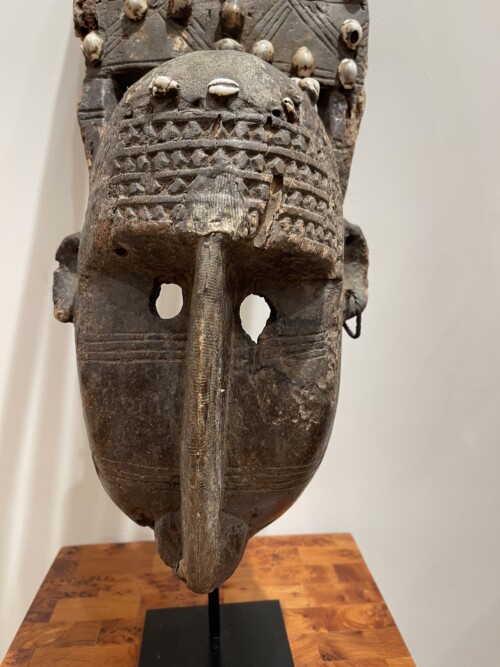
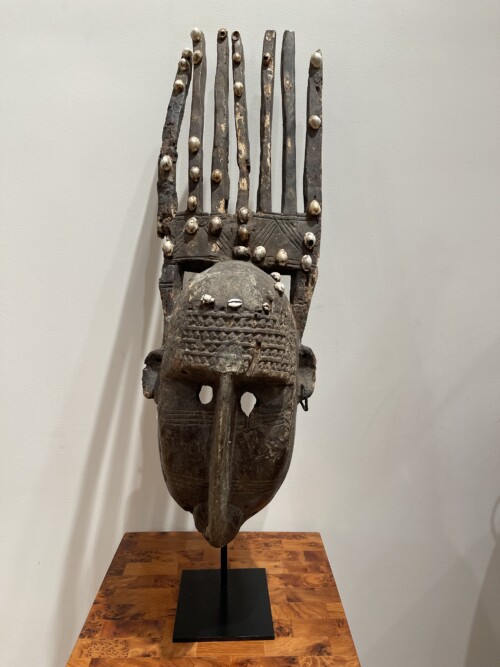 Masque « Ntomo », population Bamana, Mali Masque de la région de Ségou, à sept dents, bois rehaussé de cauris, circa 1930-1940 Dimensions : H : 61.5 cm Le masque Ntomo, est associé à un rituel d’initiation des jeunes hommes non circoncis des sociétés d’Afrique de l’Ouest. Ce type de masque est identifiable grâce à sa partie supérieure en forme de peigne de trois à huit cornes. On appelle Bamana les populations du Mali, Nord-Est de la Guinée et Nord de la Côte d’Ivoire, partageant un mode de vie commun et une langue similaire, la langue mandingue. Les Bamana ont une histoire qui remonte à l’Empire du Ghana au IIIe siècle, puis à l’Empire du Mali au XIIIe. On rencontre d’autres appellations de cette population, comme Bambara, qui est utilisée au XIIIe pour désigner ces peuples on convertis à l’islam, bamabara voulant dire “infidèles”. La vie d’un homme issu de cette population est rythmée en étapes codifiées. Un jeune garçon doit passer un rituel initiatique et éducatif dirigé par une société pour devenir un homme. Cette société initiatique forme les jeunes de 6 à 13 ans. Chaque promotion suit une formation secrète de trois à cinq ans. Les enseignements portent sur des questions métaphysiques, sur la maîtrise de soi, la place de l’homme, l'humilité, le respect. D’autres épreuves complètent l'enseignement comme l’apport de vivres, par l'aumône, le travail agricole, la chasse et la pêche. C’est lors de la fête annuelle que les jeunes faisaient des épreuves corporelles de flagellation munis d’un fouet et d’un masque Ntomo. Ces initiations sont contrôlées par les forgerons, les seuls à pouvoir confectionner ces masques sacrés. En effet, le bois est réputé comme réceptacle du nyama, une énergie dangereuse que seuls les forgerons peuvent maîtriser grâce à leurs savoirs. La confection du masque est rituelle et soumise à des conditions. Avant de sculpter, le forgeron communique avec un génie, le djinn, qui lui indique la localisation de l'arbre à abattre, sa forme et son essence. Le forgeron est soumis à des interdits comme l’abstinence, il doit sculpter seul, loin du village. Les masques, une fois sculptés, bénéficient d’une grande force spirituelle. Ntomo désigne en Bamana “jujubier”, l’arbre sur lequel étaient offerts les sacrifices. Ntomadyiri, (l’arbre du Ntomo) est considéré comme l’ancêtre des forgerons et le créateur de la société Ntomo, il serait le premier à avoir sculpté un masque. Par ailleurs, il ne faut pas envisager le masque comme un objet individuel, il est associé à un costume, à un fouet et fait partie d’un rituel. Le masque ressemble à un être cornu, griffu que l’on ne peut définir, faisant référence à des animaux stylisés. La bouche est discrète, le nez proéminent. La bouche fine, parfois absente dans les masques les plus anciens, est associée au contrôle de la parole et des actes, à la préservation des secrets et à la force face à la douleur. Le nombre de cornes est symbolique et riche de sens, il indique non pas le genre du porteur qui est un jeune garçon, mais le genre du masque. Ainsi les masques à trois ou six cornes est masculin, à quatre ou huit cornes est féminin et à deux, cinq ou sept cornes est androgyne. Dans notre cas, le masque à sept dents est associé à l'androgynie. Un autre masque bamana est présenté à la vente, il possède quatre dents, est est donc associé au genre féminin. ------------------------------------------------------------------------- Splendid Seven rams Ntomo Mask, Bamana Population, Mali, 1930-1940 Seven Rams Ntomo Mask, Ségou region, Mali, Wood, cowrie shells, reptile skin. Dimensions: 61.5 cm / 24.02 inches. The Ntomo mask is used in the initiation rituals of young men in populations across Western Africa. This type of mask is characterized by the presence of rams on the upper part, ranging from 3 to 8 rams. The Bamana people reside in Mali, the north of Guinea, and the north of Ivory Coast, sharing a common way of life and a common language (Mandingo). The Bamana population has a long history, dating back to the Ghana Empire in the 3rd century and the Mali Empire in the 13th century. They are also known as the Bambara, a name given to them by Islamic merchants, meaning "unfaithful," as they did not adopt Islam. The life of a Bamana man is highly structured. Indeed, for a young boy to transition into manhood, he must undergo an initiation ritual overseen by a society. This initiation society imparts secretive teachings to young boys aged 6 to 13. They learn about metaphysical matters, self-control, respect, humility, and the role of men in society. They are also taught survival skills such as hunting, fishing, agricultural labor, and giving alms. During the annual festival, young boys wear the Ntomo mask along with a whip and special clothing. The initiation process is controlled by blacksmiths; only they can craft these masks. Wood is considered the bearer of "nyama," a dangerous energy that only blacksmiths can control through their knowledge. The creation of the mask is a sacred act and comes with many conditions. The blacksmith must communicate with a genie who will indicate which tree to cut and where. The blacksmith then leaves the village and observes abstinence. "Ntomo" means jujube, the tree on which sacrifices were offered. "Ntomadyri," the tree of Ntomo, is considered the ancestor of blacksmiths and the creator of the Ntomo society. It is said to be the first to sculpt a mask. The mask resembles a stylized animal with rams and claws. The mouth is discreet, and the nose is prominent. The small mouth can symbolize control over speech and actions, as well as the keeping of secrets. In the oldest masks, there is no mouth. The number of rams is symbolic; it indicates the gender of the mask (not the wearer's gender). When there are 3 or 6 rams, it is a masculine mask; when there are 4 or 8, it is a feminine mask, and when there are 5 or 7, it is an androgynous mask. Ours is androgynous. We have another Bamana mask; it has 4 rams.
Masque « Ntomo », population Bamana, Mali Masque de la région de Ségou, à sept dents, bois rehaussé de cauris, circa 1930-1940 Dimensions : H : 61.5 cm Le masque Ntomo, est associé à un rituel d’initiation des jeunes hommes non circoncis des sociétés d’Afrique de l’Ouest. Ce type de masque est identifiable grâce à sa partie supérieure en forme de peigne de trois à huit cornes. On appelle Bamana les populations du Mali, Nord-Est de la Guinée et Nord de la Côte d’Ivoire, partageant un mode de vie commun et une langue similaire, la langue mandingue. Les Bamana ont une histoire qui remonte à l’Empire du Ghana au IIIe siècle, puis à l’Empire du Mali au XIIIe. On rencontre d’autres appellations de cette population, comme Bambara, qui est utilisée au XIIIe pour désigner ces peuples on convertis à l’islam, bamabara voulant dire “infidèles”. La vie d’un homme issu de cette population est rythmée en étapes codifiées. Un jeune garçon doit passer un rituel initiatique et éducatif dirigé par une société pour devenir un homme. Cette société initiatique forme les jeunes de 6 à 13 ans. Chaque promotion suit une formation secrète de trois à cinq ans. Les enseignements portent sur des questions métaphysiques, sur la maîtrise de soi, la place de l’homme, l'humilité, le respect. D’autres épreuves complètent l'enseignement comme l’apport de vivres, par l'aumône, le travail agricole, la chasse et la pêche. C’est lors de la fête annuelle que les jeunes faisaient des épreuves corporelles de flagellation munis d’un fouet et d’un masque Ntomo. Ces initiations sont contrôlées par les forgerons, les seuls à pouvoir confectionner ces masques sacrés. En effet, le bois est réputé comme réceptacle du nyama, une énergie dangereuse que seuls les forgerons peuvent maîtriser grâce à leurs savoirs. La confection du masque est rituelle et soumise à des conditions. Avant de sculpter, le forgeron communique avec un génie, le djinn, qui lui indique la localisation de l'arbre à abattre, sa forme et son essence. Le forgeron est soumis à des interdits comme l’abstinence, il doit sculpter seul, loin du village. Les masques, une fois sculptés, bénéficient d’une grande force spirituelle. Ntomo désigne en Bamana “jujubier”, l’arbre sur lequel étaient offerts les sacrifices. Ntomadyiri, (l’arbre du Ntomo) est considéré comme l’ancêtre des forgerons et le créateur de la société Ntomo, il serait le premier à avoir sculpté un masque. Par ailleurs, il ne faut pas envisager le masque comme un objet individuel, il est associé à un costume, à un fouet et fait partie d’un rituel. Le masque ressemble à un être cornu, griffu que l’on ne peut définir, faisant référence à des animaux stylisés. La bouche est discrète, le nez proéminent. La bouche fine, parfois absente dans les masques les plus anciens, est associée au contrôle de la parole et des actes, à la préservation des secrets et à la force face à la douleur. Le nombre de cornes est symbolique et riche de sens, il indique non pas le genre du porteur qui est un jeune garçon, mais le genre du masque. Ainsi les masques à trois ou six cornes est masculin, à quatre ou huit cornes est féminin et à deux, cinq ou sept cornes est androgyne. Dans notre cas, le masque à sept dents est associé à l'androgynie. Un autre masque bamana est présenté à la vente, il possède quatre dents, est est donc associé au genre féminin. ------------------------------------------------------------------------- Splendid Seven rams Ntomo Mask, Bamana Population, Mali, 1930-1940 Seven Rams Ntomo Mask, Ségou region, Mali, Wood, cowrie shells, reptile skin. Dimensions: 61.5 cm / 24.02 inches. The Ntomo mask is used in the initiation rituals of young men in populations across Western Africa. This type of mask is characterized by the presence of rams on the upper part, ranging from 3 to 8 rams. The Bamana people reside in Mali, the north of Guinea, and the north of Ivory Coast, sharing a common way of life and a common language (Mandingo). The Bamana population has a long history, dating back to the Ghana Empire in the 3rd century and the Mali Empire in the 13th century. They are also known as the Bambara, a name given to them by Islamic merchants, meaning "unfaithful," as they did not adopt Islam. The life of a Bamana man is highly structured. Indeed, for a young boy to transition into manhood, he must undergo an initiation ritual overseen by a society. This initiation society imparts secretive teachings to young boys aged 6 to 13. They learn about metaphysical matters, self-control, respect, humility, and the role of men in society. They are also taught survival skills such as hunting, fishing, agricultural labor, and giving alms. During the annual festival, young boys wear the Ntomo mask along with a whip and special clothing. The initiation process is controlled by blacksmiths; only they can craft these masks. Wood is considered the bearer of "nyama," a dangerous energy that only blacksmiths can control through their knowledge. The creation of the mask is a sacred act and comes with many conditions. The blacksmith must communicate with a genie who will indicate which tree to cut and where. The blacksmith then leaves the village and observes abstinence. "Ntomo" means jujube, the tree on which sacrifices were offered. "Ntomadyri," the tree of Ntomo, is considered the ancestor of blacksmiths and the creator of the Ntomo society. It is said to be the first to sculpt a mask. The mask resembles a stylized animal with rams and claws. The mouth is discreet, and the nose is prominent. The small mouth can symbolize control over speech and actions, as well as the keeping of secrets. In the oldest masks, there is no mouth. The number of rams is symbolic; it indicates the gender of the mask (not the wearer's gender). When there are 3 or 6 rams, it is a masculine mask; when there are 4 or 8, it is a feminine mask, and when there are 5 or 7, it is an androgynous mask. Ours is androgynous. We have another Bamana mask; it has 4 rams. -
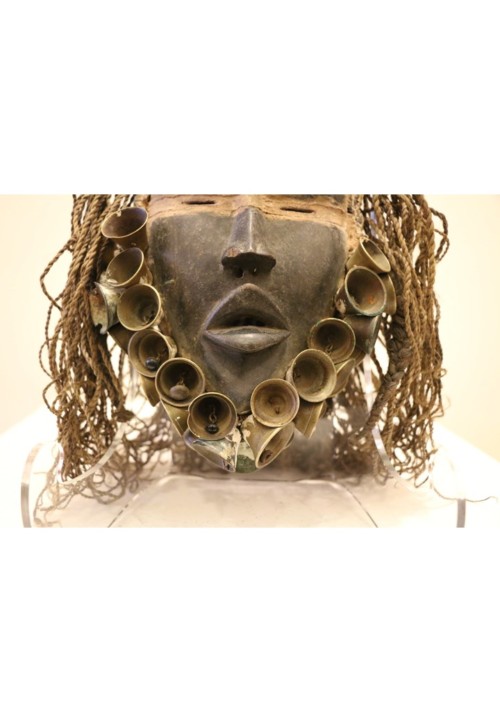
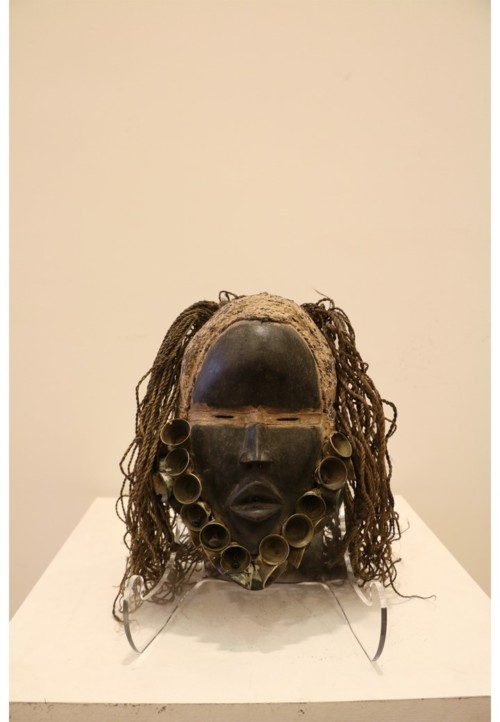 Masque Dan-Guéré Côte d'Ivoire Bois, patine d'usage noire, pigments, nombreuses clochettes en bronze, fibres végétales Première moitié du XXème siècle H : 24,5 cm ; L : 21 cm ; P : 10 cm.
Masque Dan-Guéré Côte d'Ivoire Bois, patine d'usage noire, pigments, nombreuses clochettes en bronze, fibres végétales Première moitié du XXème siècle H : 24,5 cm ; L : 21 cm ; P : 10 cm.
This exceptional mask belongs to the sought after Dan-Guéré mask family (Africa - Côte d'Ivoire/Ivory Coast). It is made from wood with a nice black patina, pigments and comes with a beautiful set of small bronze bells and hair made of vegetable fibers. It dates from the first half of the 20th century. H : 9.65 in; W : 8.27 in ; D : 3.94 in. -
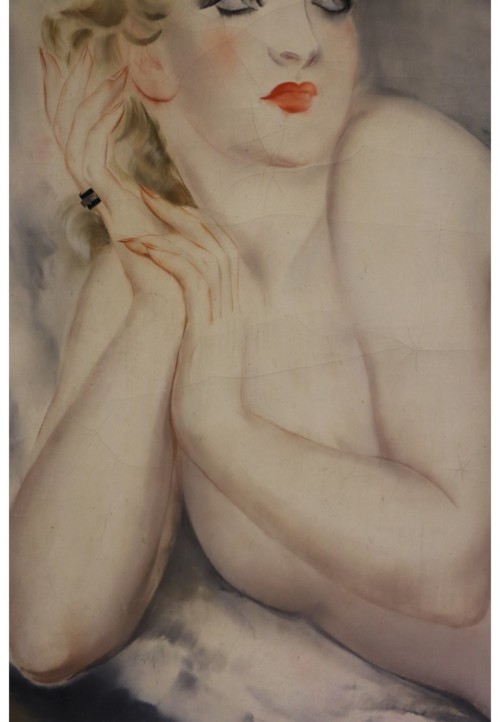
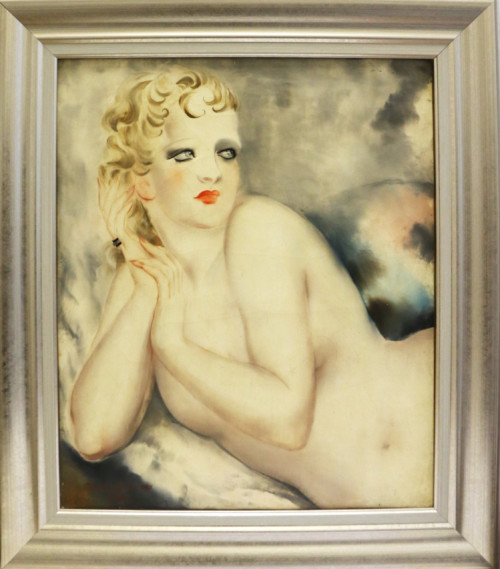 Micao KONO (1876-1954) Nu en buste Huile sur papier contrecollé sur toile Signée et datée en bas à gauche 1933 Dimensions : H : 46 cm ; L : 38 cm Pour plus d’informations sur le créateur, cliquer sur le nom : Miçao KONO
Micao KONO (1876-1954) Nu en buste Huile sur papier contrecollé sur toile Signée et datée en bas à gauche 1933 Dimensions : H : 46 cm ; L : 38 cm Pour plus d’informations sur le créateur, cliquer sur le nom : Miçao KONO
Beautiful reclining female nude by Micao Kono (1900-1979). Oil on paper pasted on canvas. Signed and dated XXXIII (33) in red bottom left. Dimension: 46 x 38cm (without frame), 52 x 44cm (with frame) Miçao Kono was a Japanese artist who came to Paris in the early 1920s. He painted in oils and watercolors, and also did a number of etchings. Micao Kono became famous with his nude portraits combining traditional Japanese style with the modernity of the Art Deco. His paintings were very popular in the Art Deco interiors. They were romantic and sensuous; his work is close to his Japanese fellow countryman Foujita. Kono’s technique was unusual as he used heavy white over which her painted his subject in pastel colors. Either by design or by the passage of time the white paint always shows signs of cracking. For more informations : Miçao KONO -
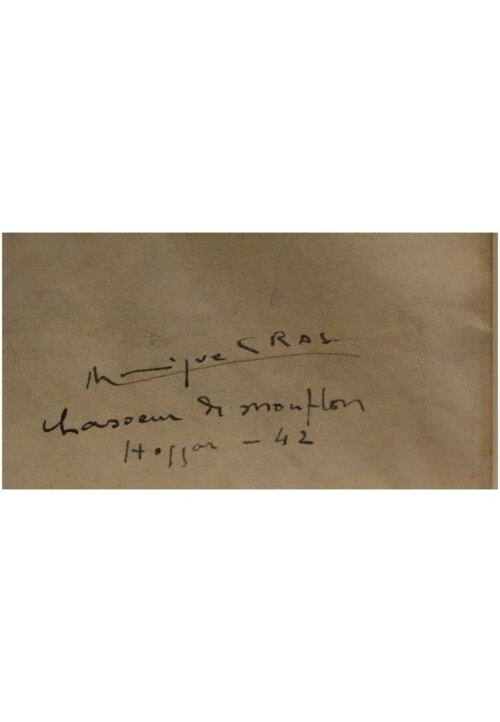
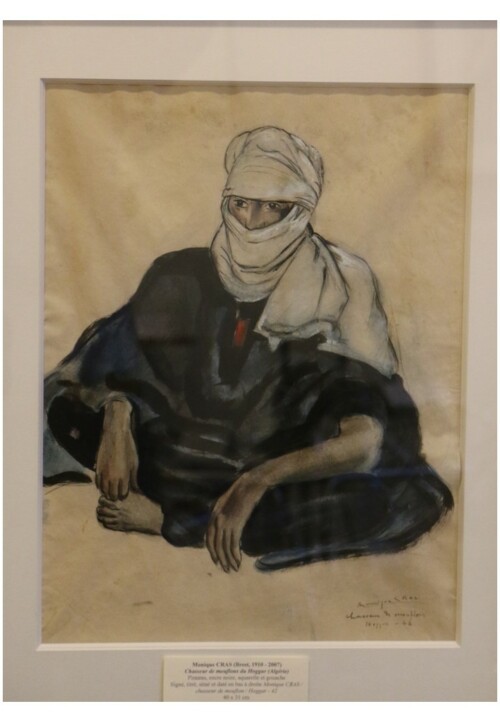 Monique CRAS Gouache titrée Chasseur de mouflon - Hoggar Pinceau, encre noire, aquarelle et gouache représentant un homme assis Signée Monique Cras et datée 42 (1942) Dimensions : H : 40 cm ; L : 31 cm (sans le cadre) H : 67,3 cm ; L : 54 cm (avec le cadre) Pour plus d’informations sur le créateur, cliquer sur le nom : Monique CRAS
Monique CRAS Gouache titrée Chasseur de mouflon - Hoggar Pinceau, encre noire, aquarelle et gouache représentant un homme assis Signée Monique Cras et datée 42 (1942) Dimensions : H : 40 cm ; L : 31 cm (sans le cadre) H : 67,3 cm ; L : 54 cm (avec le cadre) Pour plus d’informations sur le créateur, cliquer sur le nom : Monique CRAS
'Touareg in Hoggar' Gouache by Monique Cras, Art Deco, 1942.Gouache depicting a seated Touareg (also called blue man of the desert because of their indigo dyed clothing). The painting is signed Monique Cras, dated 1942 and titled 'Chasseur de mouflon dans le Hoggar' (Mouflon Hunter in the Hoggar). The Hoggar is a mountain range in southern Algeria.
Dimensions : (with frame)H : 26.38 in. ; W : 21.26 in. ; D : 1.18 in.H :67 cm ; W : 54 cm ; D : 3 cm(painting)H : 35.35 in. ; W : 11.81 in.H : 39 cm ; W : 30 cmFor more informations : Monique CRAS -
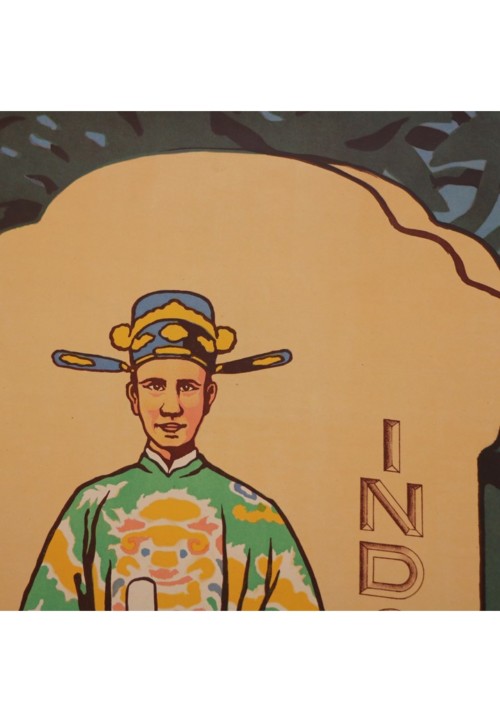
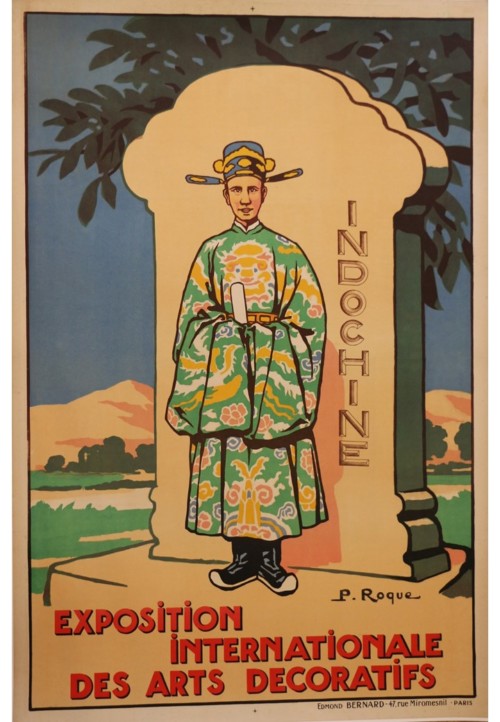 P. ROQUE Affiche lithographique non entoilée de l'Exposition Internationale des Arts Décoratifs de 1925. Indochine. Imprimée par Edmond Bernard Paris. Très bon état, marges légèrement froissées, couleurs vives et fraîches. Dimensions : H : 121,2 cm; L : 80,4 cm
P. ROQUE Affiche lithographique non entoilée de l'Exposition Internationale des Arts Décoratifs de 1925. Indochine. Imprimée par Edmond Bernard Paris. Très bon état, marges légèrement froissées, couleurs vives et fraîches. Dimensions : H : 121,2 cm; L : 80,4 cm
International Exhibition of Decorative Arts, by P. Roque Lithographic poster for the International Exhibition of Decorative Arts, from 1925. Printed by Edmond Bernard Paris. Excellent condition, minor creases in margins, bright and fresh colours.Dimensions :H : 121,2 cm ; W : 80,4 cm -
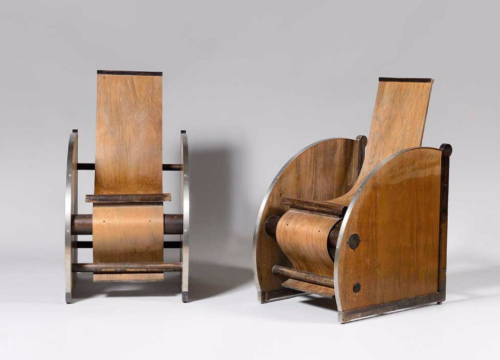
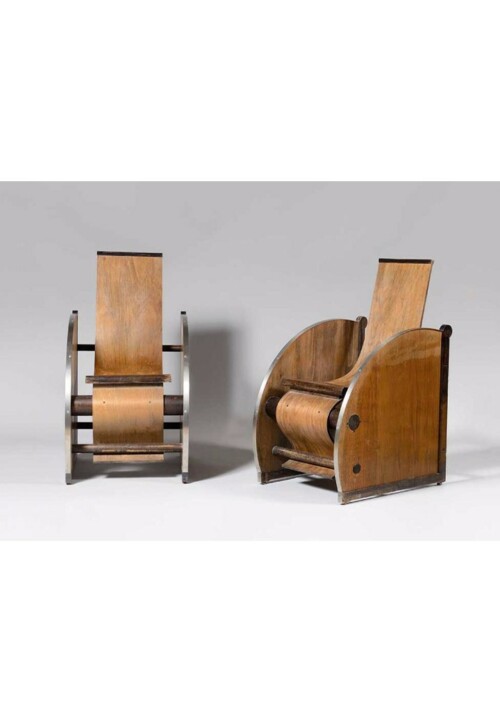 Paire de fauteuils, travail moderniste Paire de fauteuils en bois et métal chromé, avec assise en contreplaqué, moulé entre deux montants arrondis pleins. Ces fauteuils proviennent d'un club d'hommes d'affaires de la région de Longwy. Circa 1927. Dimensions : H : 98 cm; L : 65 cm ; Prof. : 54 cm
Paire de fauteuils, travail moderniste Paire de fauteuils en bois et métal chromé, avec assise en contreplaqué, moulé entre deux montants arrondis pleins. Ces fauteuils proviennent d'un club d'hommes d'affaires de la région de Longwy. Circa 1927. Dimensions : H : 98 cm; L : 65 cm ; Prof. : 54 cm
Pair of modernist armchairs Pair of modernist armchairs made from wood and chrome-plated metal, with a plywood seat, between two rounded armrests. Circa 1927. Dimensions : H : 38.58 in. ; W : 25.59 in. ; D : 21.26 in. H : 98 cm ; L : 65 cm ; Prof. : 54 cm -
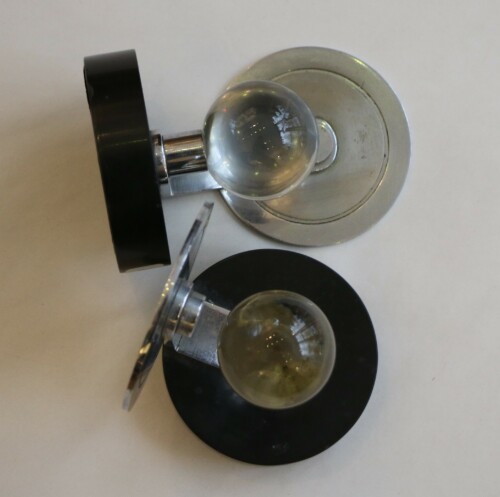
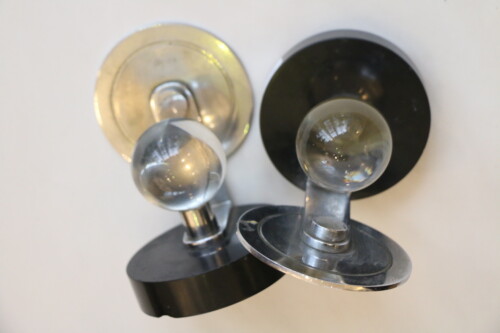 Paire de serre livres modernistes En métal nickelé à base en marbre noir et agrémentés d'une sphère en verre translucide H : 14 cm ; L : 9 cm
Paire de serre livres modernistes En métal nickelé à base en marbre noir et agrémentés d'une sphère en verre translucide H : 14 cm ; L : 9 cm
Pair of modernist bookends In nickel-plated metal with a black marble base and embellished with a translucent glass sphere Dimensions : H : 14 cm ; L : 9 cm H : 5.52 in ; L : 3.55 in -
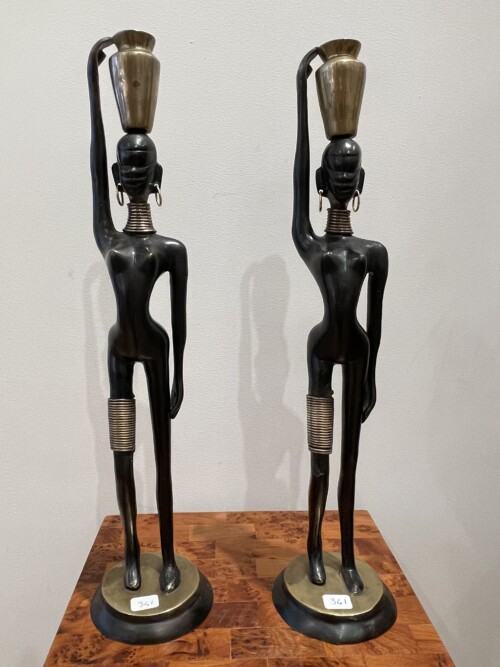
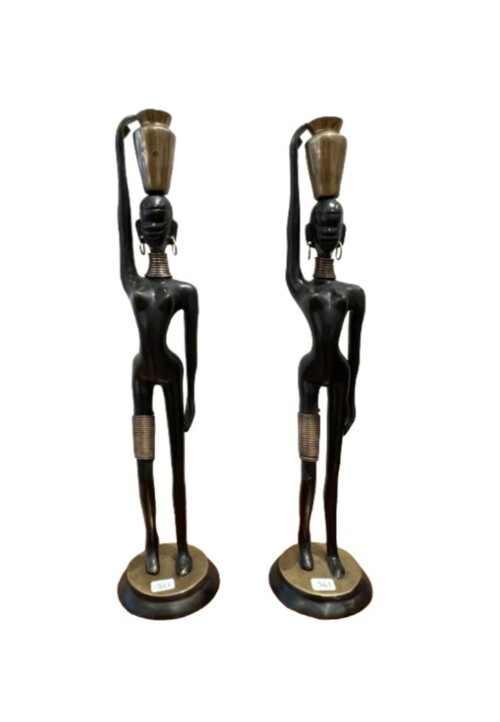 HAGENAUER (d’après), paire de statuettes porteuses d’eau, « femme girafe » Bronze à double patine noire et dorée Dimensions : 45 cm Paire de bronze représentant une africaine portant de l’eau. La femme présente un corps stylisé aux proportions élancées dégangeant une grande élégance. Les membres sont allongés, le dos courbé pour laisser apparaître et mettre en valeur les attributs féminins. Un léger mouvement se dessine dans les jambes, évitant l’effet statique et animant la figure. Les traits du visage sont stylisés et simplifiés. Le corps est en bronze à patine noire, sombre, ce qui met en valeur la ligne et les courbes. Seuls les bijoux de cuisse, de cou, boucles d’oreilles et vase sont dorés ce qui relève les courbes et met en valeur le corps. Cette paire est caractéristique du style de Karl Hagenauer (1898-1956), un célèbre designer autrichien, spécialisé dans la production d’objets en métal et en bois, reconnu pour ses œuvres modernes et stylisées. Ce modèle date des années 1970, où de nombreuses rééditions des classiques de Hagenauer ont été réalisées. Nous présentons également dans notre galerie un bronze grandeur nature du même modèle.
HAGENAUER (d’après), paire de statuettes porteuses d’eau, « femme girafe » Bronze à double patine noire et dorée Dimensions : 45 cm Paire de bronze représentant une africaine portant de l’eau. La femme présente un corps stylisé aux proportions élancées dégangeant une grande élégance. Les membres sont allongés, le dos courbé pour laisser apparaître et mettre en valeur les attributs féminins. Un léger mouvement se dessine dans les jambes, évitant l’effet statique et animant la figure. Les traits du visage sont stylisés et simplifiés. Le corps est en bronze à patine noire, sombre, ce qui met en valeur la ligne et les courbes. Seuls les bijoux de cuisse, de cou, boucles d’oreilles et vase sont dorés ce qui relève les courbes et met en valeur le corps. Cette paire est caractéristique du style de Karl Hagenauer (1898-1956), un célèbre designer autrichien, spécialisé dans la production d’objets en métal et en bois, reconnu pour ses œuvres modernes et stylisées. Ce modèle date des années 1970, où de nombreuses rééditions des classiques de Hagenauer ont été réalisées. Nous présentons également dans notre galerie un bronze grandeur nature du même modèle.
Stunning pair of African lady carrying water, in the style of Karl Hagenauer 1970’s, Bronze with double black and gilt patina, Dimensions : 45 cm / 17.72 inches Stunning pair of African women carrying water. The woman's body is stylized with elegant elongated proportions. Her limbs are elongated, her back curved, emphasizing her feminine attributes. The legs are in motion, adding dynamism to the sculpture. Her facial features are simplified. The body is cast in black bronze, which enhances the curves and lines. Only the jewelry is gilded, further accentuating the body. This pair is in the typical style of Karl Hagenauer (1898-1956), a renowned Austrian designer specialized in wood and metalwork, famous for his stylized and modern figures. We also feature in our gallery a life-size bronze of the same model. -
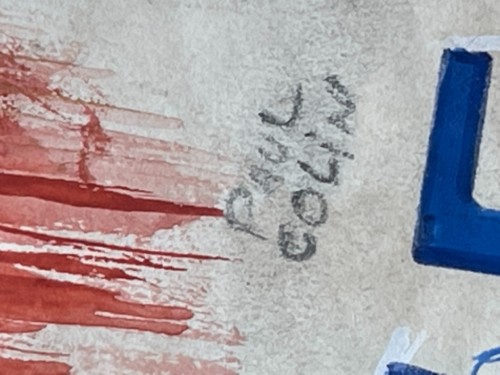
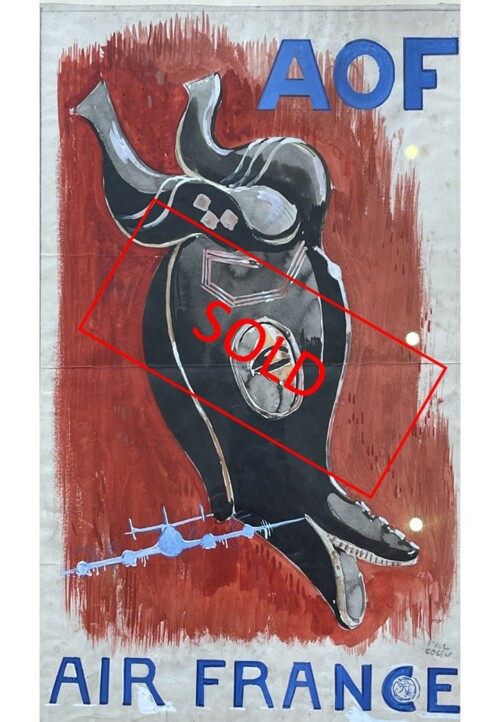 Paul Colin (1892-1985) Projet d'affiche pour Air France Gouache sur papier Signée Années 50 Dimensions : H : 50 cm ; L : 30.5 cm Pour plus d’informations sur le créateur, cliquer sur son nom : Paul Colin
Paul Colin (1892-1985) Projet d'affiche pour Air France Gouache sur papier Signée Années 50 Dimensions : H : 50 cm ; L : 30.5 cm Pour plus d’informations sur le créateur, cliquer sur son nom : Paul Colin
Poster project for Air France by Paul Colin (1892-1985) Gouache on paper Signed 1950s Dimensions : H : 19.69 in ; W : 12.01 in H : 50 cm ; W : 30.5 cm For more information : Paul Colin -
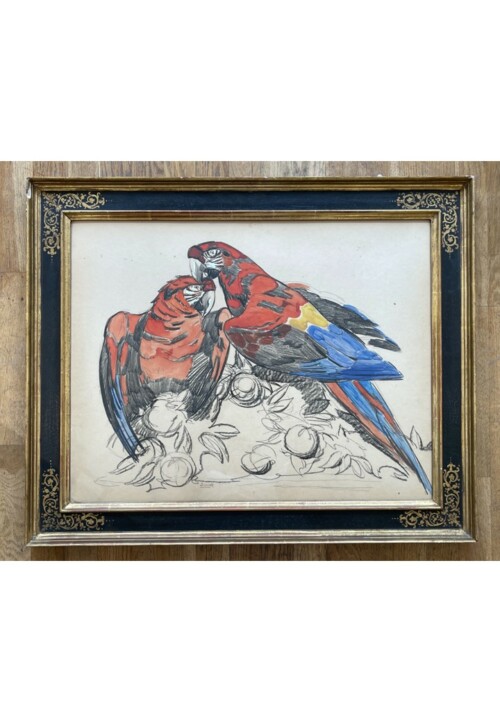
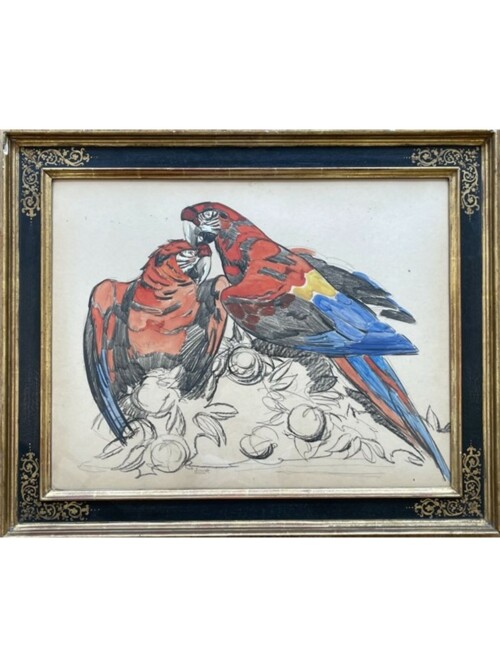 Superbe tableau réalisé par le peintre Paul Jouve (1866-1924) représentant deux perroquets des années 1930. Paul Jouve est un illustrateur et sculpteur français, passionné depuis son plus jeune âge par les animaux, en témoigne sa fabuleuse représentation de ces deux volatiles. Il est le plus célèbre peintre animalier de la période Art Déco. Les peintures originales de Paul Jouve sont rares et très recherchées. L'œuvre a été réalisée sur papier grâce à différentes techniques à la fois sèches, le graphite et le fusain et humides, l'aquarelle, marquant la virtuosité technique de l'artiste. Ce tableau est signé "Jouve" en partie inférieure et certifié par Monsieur Dominique Suisse, l'ayant droit de Paul Jouve. Le montage d'origine a été réalisé par Havard Frères, le tampon de fournisseur étant au revers du panneau de montage. Le papier fort de l'œuvre est posé sur le panneau, mais n'est pas collé. Taille sans le cadre : 55.4 x 70.5 cm Taille avec le cadre : 83 cm x 68 cm profondeur : 5cm Pour plus d'informations sur Paul Jouve, cliquez ici.
Superbe tableau réalisé par le peintre Paul Jouve (1866-1924) représentant deux perroquets des années 1930. Paul Jouve est un illustrateur et sculpteur français, passionné depuis son plus jeune âge par les animaux, en témoigne sa fabuleuse représentation de ces deux volatiles. Il est le plus célèbre peintre animalier de la période Art Déco. Les peintures originales de Paul Jouve sont rares et très recherchées. L'œuvre a été réalisée sur papier grâce à différentes techniques à la fois sèches, le graphite et le fusain et humides, l'aquarelle, marquant la virtuosité technique de l'artiste. Ce tableau est signé "Jouve" en partie inférieure et certifié par Monsieur Dominique Suisse, l'ayant droit de Paul Jouve. Le montage d'origine a été réalisé par Havard Frères, le tampon de fournisseur étant au revers du panneau de montage. Le papier fort de l'œuvre est posé sur le panneau, mais n'est pas collé. Taille sans le cadre : 55.4 x 70.5 cm Taille avec le cadre : 83 cm x 68 cm profondeur : 5cm Pour plus d'informations sur Paul Jouve, cliquez ici.
This stunning painting was created by the French artist Paul Jouve (1866-1924) in the 1930's and depicts two parrots. Paul Jouve was an illustrator and sculptor who had a lifelong passion for animals, as evidenced by his fabulous portrayal of these birds. He is the most famous animal painter in the Art Deco period. Original paintings by Jouve are rare and very much sought and looked after. The artwork was executed using different techniques including dry mediums such as graphite and charcoal, as well as wet techniques like watercolor showcasting the artist's technical virtuosity. The painting is signed "Jouve" on the lower part and certified by Mr. Dominique Suisse, the rightful heir of Paul Jouve. The mounting is old and was done by Havard Frères with the supplier's stamp on the back of the mounting panel. The strong paper of the artwork is laid on the panel but is not glued. Size without frame : 21.82 x 27.56 inches/55.4 x 70 cm Size with frame : 32.68 x 26.78 inches , depth 1.97 inches / 83 cm x 68 cm depth : 5cm For more informations about Paul Jouve, click here -
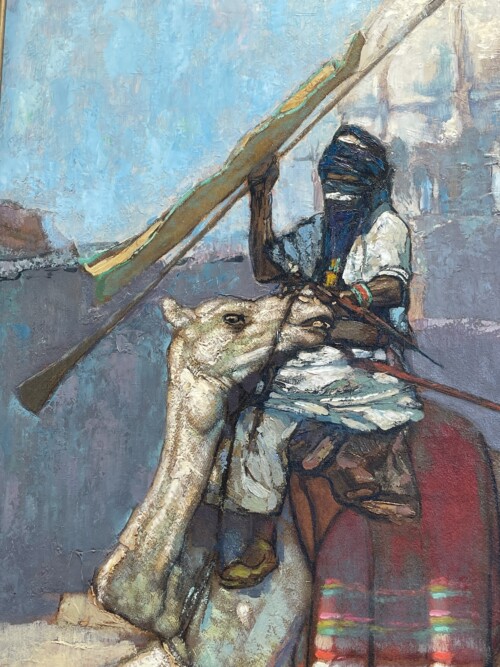
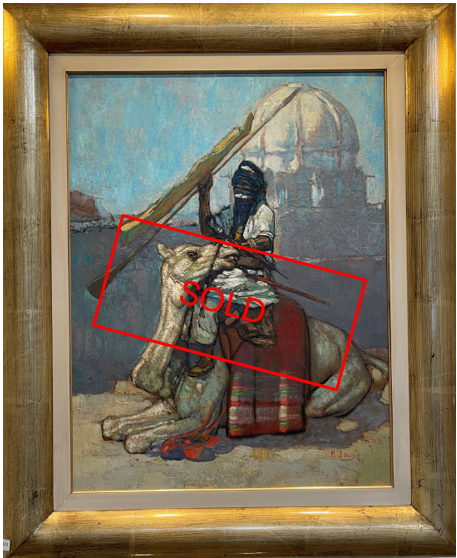 Paul JOUVE (1878-1973) : "Touareg Et Méhari Baraquant". Vers 1932. Cette peinture est l'une des meilleures œuvres du célèbre artiste Paul Jouve. Elle possède une documentation parfaite étant publiée dans l'ouvrage de référence par Félix Marcilhac et est vendue avec un certificat de Mr Suisse qui est l'expert de Paul Jouve. Il a été exposé dans au moins 2 expositions au cours des années 30 et 40 (1932 et 1943) - voir ci-dessous pour les détails. Il a également une parfaite origine ayant été acheté à la collection Paul Jouve et est resté dans la même famille depuis lors. Huile sur panneau (masonite) Signé et situé « Niger » en bas à droite Autocollants anciens au dos Dimensions hors cadre : hauteur : 64,5 cm, largeur. 50cm Cadre : 84 x 69 cm Bibliographie/Bibliography Paul JOUVE, vie et œuvre par Félix Marcilhac Éditions de l'Amateur - Paris 2005 Reproduit en pleine page P.207. Des expositions: - Salon de la Société Nationale des Beaux Arts Paris 1932. sous le numéro 1141 - Exposition Paul Jouve, galerie l'Art Français, 1943. 24 rue de la paix, Paris 8e, du 23 octobre au 6 novembre n° 19 Origine :Collection Paul Jouve, puis achat direct à l'artiste. Dans la même famille depuis. Pour plus d’informations sur le créateur, cliquer sur le nom : Paul JOUVE
Paul JOUVE (1878-1973) : "Touareg Et Méhari Baraquant". Vers 1932. Cette peinture est l'une des meilleures œuvres du célèbre artiste Paul Jouve. Elle possède une documentation parfaite étant publiée dans l'ouvrage de référence par Félix Marcilhac et est vendue avec un certificat de Mr Suisse qui est l'expert de Paul Jouve. Il a été exposé dans au moins 2 expositions au cours des années 30 et 40 (1932 et 1943) - voir ci-dessous pour les détails. Il a également une parfaite origine ayant été acheté à la collection Paul Jouve et est resté dans la même famille depuis lors. Huile sur panneau (masonite) Signé et situé « Niger » en bas à droite Autocollants anciens au dos Dimensions hors cadre : hauteur : 64,5 cm, largeur. 50cm Cadre : 84 x 69 cm Bibliographie/Bibliography Paul JOUVE, vie et œuvre par Félix Marcilhac Éditions de l'Amateur - Paris 2005 Reproduit en pleine page P.207. Des expositions: - Salon de la Société Nationale des Beaux Arts Paris 1932. sous le numéro 1141 - Exposition Paul Jouve, galerie l'Art Français, 1943. 24 rue de la paix, Paris 8e, du 23 octobre au 6 novembre n° 19 Origine :Collection Paul Jouve, puis achat direct à l'artiste. Dans la même famille depuis. Pour plus d’informations sur le créateur, cliquer sur le nom : Paul JOUVE
Paul JOUVE (1878-1973): "Touareg and Mehari Baraquant". Circa 1932. This painting is one of the best works of the famous artist Paul Jouve. It has a perfect documentation being published in the reference book by Félix Marcilhac and is sold with a certificate of Mr Suisse who is the expert of Paul Jouve. It was exhibited in at least 2 exhibitions during the 1930s and 1940s (1932 and 1943) - see below for details. It also has a perfect provenance having been bought from the Paul Jouve collection and has remained in the same family ever since. Oil on panel (Masonite) Signed and located "Niger" lower right Old stickers on the back Dimensions out of frame: height: 64.5 cm, width. 50cm Frame: 84 x 69 cm For more informations : : Paul JOUVE -
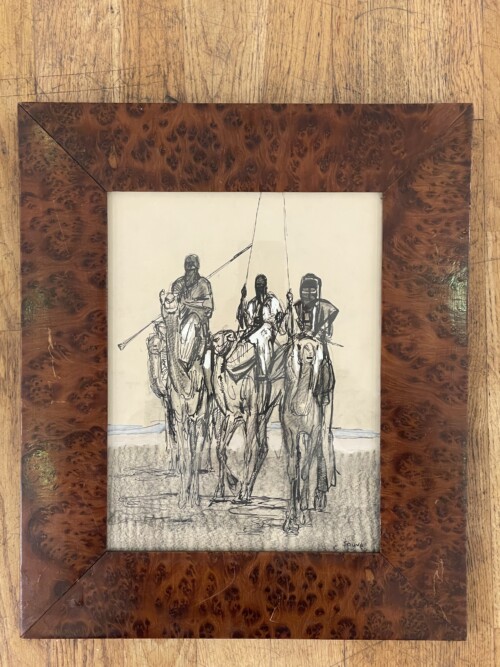
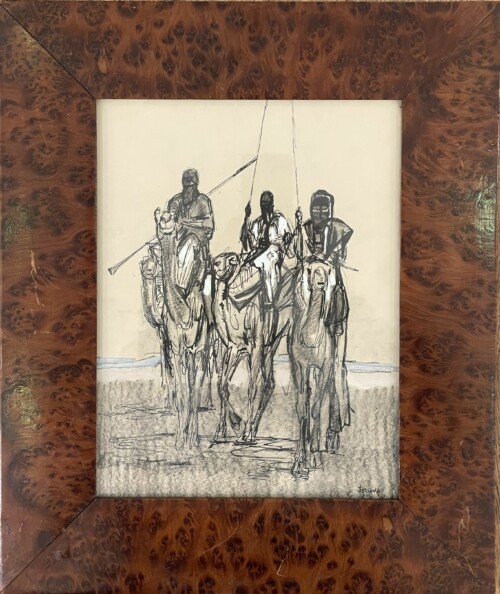 Fabuleux dessin de méharistes sur des dromadaires par Paul Jouve. Paul Jouve est un illustrateur et sculpteur français, passionné depuis son plus jeune âge par les animaux, qu’il découvre au Muséum et dans les zoos parisiens. Il est le plus célèbre peintre animalier de la période Art Déco. En 1931, Paul Jouve embarque pour l’Afrique depuis Bordeaux. Il se rend à Dakar, et entreprend un périple à partir du Sénégal vers le Soudan, le Niger et le Dahomey. C’est durant ce voyage qu’il réalise de nombreux dessins et peintures de méharistes et Touaregs. Notre dessin est issu de ce voyage, comme l’huile sur carton représentant un Méhari du Niger également proposée dans notre galerie. Ces dessins de voyage permettent à l’artiste d’étudier de nouveaux animaux et de représenter les peuples qu’il découvre. Une fois rentré en France, il réalise de nombreuses lithographies et compositions issues de ses notes et croquis de voyage. Les peintures et dessins originaux de Paul Jouve sont rares et très recherchés. L’œuvre a été réalisée sur papier grâce à différentes techniques à la fois sèches, le crayon et humides, l’encre de chine et la gouache marquant la virtuosité technique de l’artiste. Cette œuvre est vendue avec un certificat d'authenticité par Dominique Suisse. Dimensions : H. 30cm L. 22.5cm Pour en apprendre un peu plus sur l'artiste, cliquez ici
Fabuleux dessin de méharistes sur des dromadaires par Paul Jouve. Paul Jouve est un illustrateur et sculpteur français, passionné depuis son plus jeune âge par les animaux, qu’il découvre au Muséum et dans les zoos parisiens. Il est le plus célèbre peintre animalier de la période Art Déco. En 1931, Paul Jouve embarque pour l’Afrique depuis Bordeaux. Il se rend à Dakar, et entreprend un périple à partir du Sénégal vers le Soudan, le Niger et le Dahomey. C’est durant ce voyage qu’il réalise de nombreux dessins et peintures de méharistes et Touaregs. Notre dessin est issu de ce voyage, comme l’huile sur carton représentant un Méhari du Niger également proposée dans notre galerie. Ces dessins de voyage permettent à l’artiste d’étudier de nouveaux animaux et de représenter les peuples qu’il découvre. Une fois rentré en France, il réalise de nombreuses lithographies et compositions issues de ses notes et croquis de voyage. Les peintures et dessins originaux de Paul Jouve sont rares et très recherchés. L’œuvre a été réalisée sur papier grâce à différentes techniques à la fois sèches, le crayon et humides, l’encre de chine et la gouache marquant la virtuosité technique de l’artiste. Cette œuvre est vendue avec un certificat d'authenticité par Dominique Suisse. Dimensions : H. 30cm L. 22.5cm Pour en apprendre un peu plus sur l'artiste, cliquez ici
Fabulous drawing of Méharistes on dromedaries by Paul Jouve. Paul Jouve was a French illustrator and sculptor, captivated by animals from a young age, exploring them at the Museum and Parisian zoos. He is the most renowned animal painter of the Art Deco period. In 1931, Paul Jouve set off for Africa from Bordeaux, reaching Dakar and embarking on a journey from Senegal to Sudan, Niger, and Dahomey. It was during this expedition that he created numerous drawings and paintings of Méharistes and Tuaregs. Our drawing originates from this voyage, much like the oil on cardboard depicting a Niger Méhari, also featured in our gallery. These travel drawings allowed the artist to study new animals and represent the peoples he encountered. Upon returning to France, he produced numerous lithographs and compositions based on his travel notes and sketches. Original paintings and drawings by Paul Jouve are rare and highly sought after. The artwork was created on paper using various techniques, both dry, such as pencil, and wet, such as India ink and gouache, showcasing the artist's technical virtuosity. This artwork is sold with a certificate of authenticity by Dominique Suisse. Dimensions : H. 30cm L. 22.5cm Height: 11.811 inches Width: 8.858 inches For more informations about the artist, please click here -
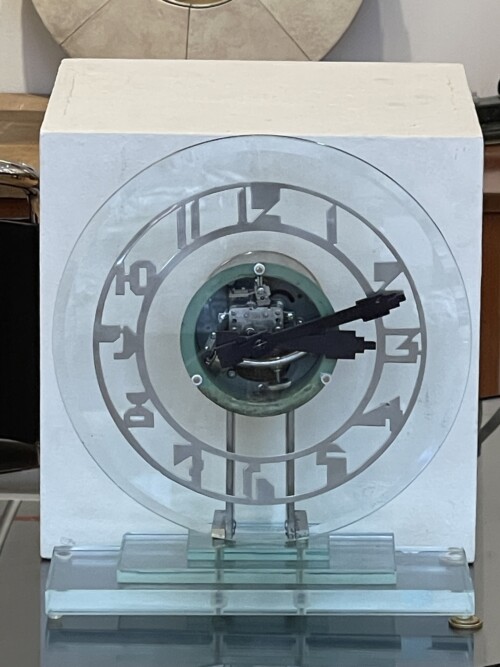
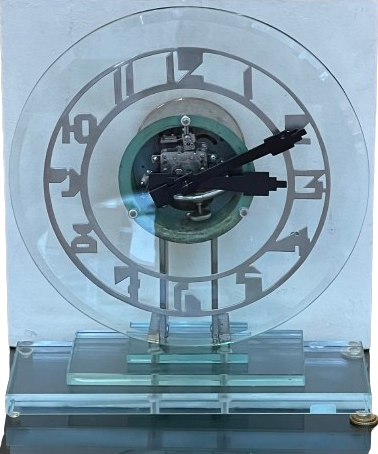 Exceptionnelle pendule électrique (mue par une pile ronde standard LR14) Art Déco transparente en verre à boîtier rond nickelé sur un socle également en verre à trois étages. Le cadran, typiquement Art Déco, est transparent et laisse apparent dans un double entourage de cercles le mouvement du balancier électro-magnétique. Les aiguilles sont de formes géométriques, caractéristiques de la période et des modèles documentés de Léon HATOT. La pendule est signée « Ato ». Elle est en bon état, fonctionne et sort d'une révision par un horloger professionnel. ATO est une marque d’horlogerie prestigieuse fondée par Léon Hatot (1983-1953), il est formé à l’Ecole Nationale d’Horlogerie de Besançon de 1895 à 1898 ; ce n’est qu’en 1905 qu’il se lance dans la production et la gravure de boîtiers de montres en métaux précieux. Entre 1918 et 1919 est construite l’usine de la "fabrique d’horlogerie et de joaillerie" spécialisée dans l’horlogerie de luxe. En 1923, il s’intéresse alors aux évolutions possible dans l’horlogerie et collabore alors avec l’ingénieur des Arts et Métiers Marius Lavet, diplômé de l’Ecole supérieure d’Electricité. Il commence par la suite la fabrication de pendules et d’horloges électriques, commercialisées sous la marque Ato à partir de 1923. Deux ans plus tard en 1925, il remporte, le grand prix d’art décoratif. Léon Hatot est considéré comme l’un des pionniers des pendules électriques haut de gamme. Hauteur : 34 cm Largeur : 30 cm Profondeur : 12cm
Exceptionnelle pendule électrique (mue par une pile ronde standard LR14) Art Déco transparente en verre à boîtier rond nickelé sur un socle également en verre à trois étages. Le cadran, typiquement Art Déco, est transparent et laisse apparent dans un double entourage de cercles le mouvement du balancier électro-magnétique. Les aiguilles sont de formes géométriques, caractéristiques de la période et des modèles documentés de Léon HATOT. La pendule est signée « Ato ». Elle est en bon état, fonctionne et sort d'une révision par un horloger professionnel. ATO est une marque d’horlogerie prestigieuse fondée par Léon Hatot (1983-1953), il est formé à l’Ecole Nationale d’Horlogerie de Besançon de 1895 à 1898 ; ce n’est qu’en 1905 qu’il se lance dans la production et la gravure de boîtiers de montres en métaux précieux. Entre 1918 et 1919 est construite l’usine de la "fabrique d’horlogerie et de joaillerie" spécialisée dans l’horlogerie de luxe. En 1923, il s’intéresse alors aux évolutions possible dans l’horlogerie et collabore alors avec l’ingénieur des Arts et Métiers Marius Lavet, diplômé de l’Ecole supérieure d’Electricité. Il commence par la suite la fabrication de pendules et d’horloges électriques, commercialisées sous la marque Ato à partir de 1923. Deux ans plus tard en 1925, il remporte, le grand prix d’art décoratif. Léon Hatot est considéré comme l’un des pionniers des pendules électriques haut de gamme. Hauteur : 34 cm Largeur : 30 cm Profondeur : 12cm
ATO glass transparent electric pendulum, Art Deco, France, Circa 1930 Exceptional electric pendulum (powered by a standard round battery LR14) Art Deco transparent glass with nickel-plated round case on a base also three-storey glass. The dial, typically Art Deco, is transparent and leaves apparent in a double circle of circles the movement of the electro-magnetic balance. The hands are geometric shapes, characteristic of the period and documented models of Léon HATOT. The clock is signed «Ato». It is in good condition, works and comes out of a revision by a professional watchmaker. ATO is a prestigious watchmaking brand founded by Léon Hatot (1983-1953), it was formed at the Ecole Nationale d'Horlogerie de Besançon from 1895 to 1898; it was only in 1905 that it launched into the production and engraving of watch cases made of precious metals. Between 1918 and 1919 is built the factory of the "factory of clock industry and jewellery" specialized in the clock industry of luxury. In 1923, he became interested in possible developments in watchmaking and then collaborated with the engineer of Arts and Crafts Marius Lavet, a graduate of the Ecole supérieure d'Electricité. He then began manufacturing electric clocks and clocks, marketed under the brand Ato from 1923. Two years later in 1925, he won the Grand Prix for decorative art. Léon Hatot is considered one of the pioneers of high-end electric clocks. Height : 86.36 inches Width : 76.2 inches Depth : 30.48 inches -
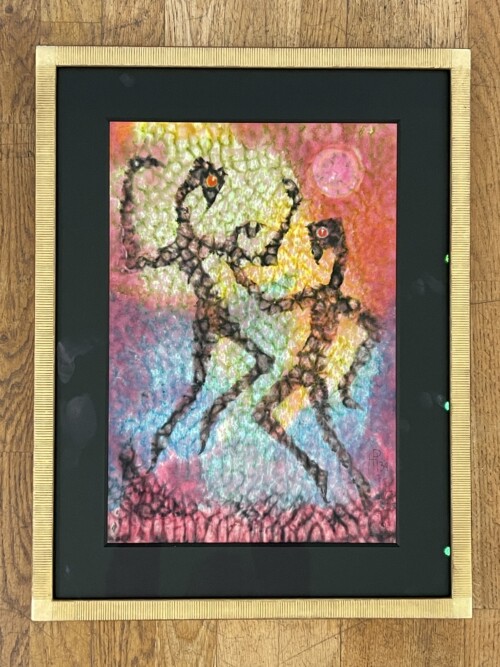
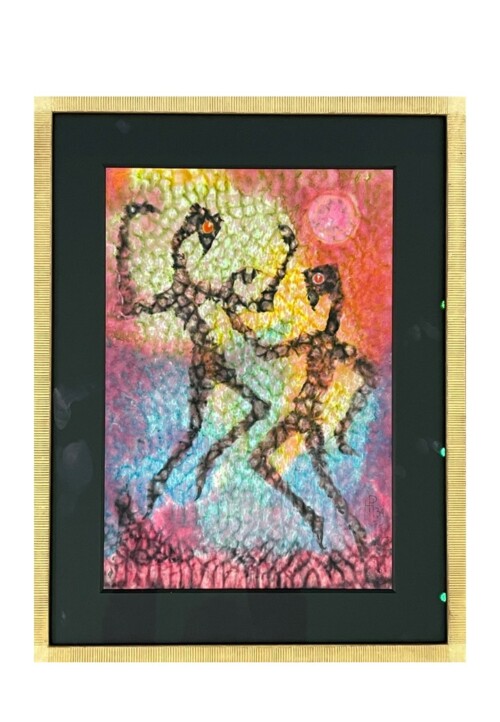 PFEIFFER Herni Ernst (1907-1994) « Pas de deux », 1931, aquarelle, Monogrammée et datée en bas à droite. Dimensions : 42 x29 cm Henri Pfeiffer est un artiste allemand qui commence ses études artistiques à l’université de Bonn puis au Bauhaus auprès de Paul Klee et de Kandinsky. Ses créations sont marquées par un sens du mouvement, du dynamisme et de la couleur proche des avant-gardes européennes. Ses personnages dansants aux corps anguleux qui viennent se distinguer du fond coloré traduisent une atmosphère dansante et envoûtante. Henri Pfeiffer a longuement travaillé sur la technique picturale, sur les différentes manières de développer une peinture. Ainsi ses œuvres sont réalisées avec des techniques expérimentales que l’artiste développe comme cette aquarelle réalisée avec des pigments non miscibles. Le rendu est d’une extrême originalité et permet d’accentuer l’éclat des couleurs et la sensation de mouvement. Arrêté par la Gestapo à la dissolution du Bauhaus en 1933 il ne reprendra jamais la peinture et devient médecin ophtalmologue spécialisé dans la perception des couleurs. Il y consacre notamment un livre en 1956 “l’Harmonie des Couleurs’’ et enseigne la chromatologie à Paris (où il s'est installé après la guerre) à l’Ecole des Arts Appliqués dès 1960. Cette œuvre est titrée “Pas de deux”, elle est monogrammée et datée en bas à droite. Pour découvrir l'artiste cliquez ici
PFEIFFER Herni Ernst (1907-1994) « Pas de deux », 1931, aquarelle, Monogrammée et datée en bas à droite. Dimensions : 42 x29 cm Henri Pfeiffer est un artiste allemand qui commence ses études artistiques à l’université de Bonn puis au Bauhaus auprès de Paul Klee et de Kandinsky. Ses créations sont marquées par un sens du mouvement, du dynamisme et de la couleur proche des avant-gardes européennes. Ses personnages dansants aux corps anguleux qui viennent se distinguer du fond coloré traduisent une atmosphère dansante et envoûtante. Henri Pfeiffer a longuement travaillé sur la technique picturale, sur les différentes manières de développer une peinture. Ainsi ses œuvres sont réalisées avec des techniques expérimentales que l’artiste développe comme cette aquarelle réalisée avec des pigments non miscibles. Le rendu est d’une extrême originalité et permet d’accentuer l’éclat des couleurs et la sensation de mouvement. Arrêté par la Gestapo à la dissolution du Bauhaus en 1933 il ne reprendra jamais la peinture et devient médecin ophtalmologue spécialisé dans la perception des couleurs. Il y consacre notamment un livre en 1956 “l’Harmonie des Couleurs’’ et enseigne la chromatologie à Paris (où il s'est installé après la guerre) à l’Ecole des Arts Appliqués dès 1960. Cette œuvre est titrée “Pas de deux”, elle est monogrammée et datée en bas à droite. Pour découvrir l'artiste cliquez ici
Henri Pfeiffer is a German artist who pursued artistic studies at the University of Bonn and later at the Bauhaus under the guidance of Paul Klee and Kandinsky. His creations are characterized by a sense of movement, dynamism, and color, closely tied to European avant-gardes. His dancing figures with angular bodies, distinct from the colorful backgrounds, convey a captivating and enchanting atmosphere. Henri Pfeiffer extensively explored pictorial techniques and different ways of developing paintings. As a result, his works were created using experimental techniques that the artist developed, such as this watercolor made with non-miscible pigments. The outcome is extremely original, emphasizing the brilliance of colors and the sensation of movement. Arrested by the Gestapo during the dissolution of the Bauhaus in 1933, he never returned to painting and became an ophthalmologist, a recognized specialist in color perception. He dedicated a book to this subject in 1956, titled 'L’Harmonie des Couleurs' (The Harmony of Colors), and taught chromatology in Paris (where he settled after the war) at the School of Applied Arts from 1960. This artwork is titled 'Pas de Deux,' monogrammed, and dated at the bottom right. For more informations about Henri Pfeiffer, please click here Dimensions : 42 x 29 cm 16.53 x 11.41 inches -
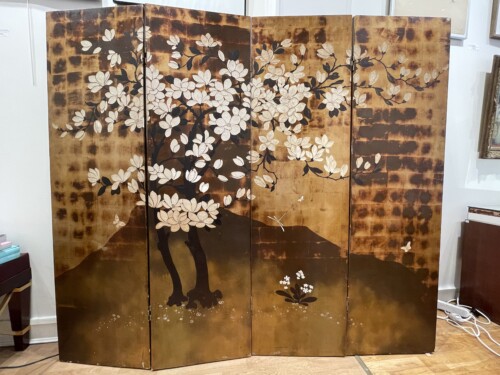
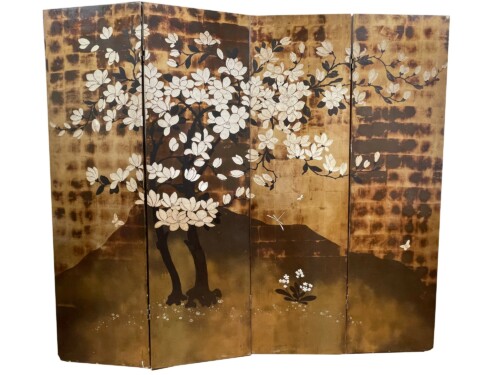 Pierre BOBOT (1902-1974) Paravent en laque Exceptionnel paravent de style Art Déco, laqué sur les deux faces à 4 panneaux par Pierre Bobot. Une face en laque de couleur sur un fond de feuilles dorées à décor de fleurs et d'insectes magnolias. Signé et monogrammé en bas à droite. Au dos, technique de la laque "déchirée", décor gravé de phénix (harigaki), oiseaux et papillons. Dimensions : Chaque panneau 50x175cm Total : 200x175cm Ce paravent n'est pas restauré et présente un certain nombre de petites éraflures/pertes (voir photos) principalement sur la face arrière. Une petite restauration lui redonnerait tout son éclat. Pour plus d’informations sur le créateur, cliquer sur son nom : Pierre Bobot
Pierre BOBOT (1902-1974) Paravent en laque Exceptionnel paravent de style Art Déco, laqué sur les deux faces à 4 panneaux par Pierre Bobot. Une face en laque de couleur sur un fond de feuilles dorées à décor de fleurs et d'insectes magnolias. Signé et monogrammé en bas à droite. Au dos, technique de la laque "déchirée", décor gravé de phénix (harigaki), oiseaux et papillons. Dimensions : Chaque panneau 50x175cm Total : 200x175cm Ce paravent n'est pas restauré et présente un certain nombre de petites éraflures/pertes (voir photos) principalement sur la face arrière. Une petite restauration lui redonnerait tout son éclat. Pour plus d’informations sur le créateur, cliquer sur son nom : Pierre Bobot
Lacquered screen Exceptional 2-sided 4-panel lacquered screen by Pierre Bobot (French 1902-1974). Art Deco. One side in color lacquer on a background of golded leaf with a decor of magnola flowers and insects. Signed and monogrammed bottom right. On the back side, harigaki technique, engraved decor of phenix, birds and butterflies. Dimensions: Each panel 50x175cm Overall: 200x175cm This screen is unrestored and shows a number of small scraches/losses (see photos) mostly on the back side. A small restoration would give it back its full luster. For more informations : Pierre Bobot -
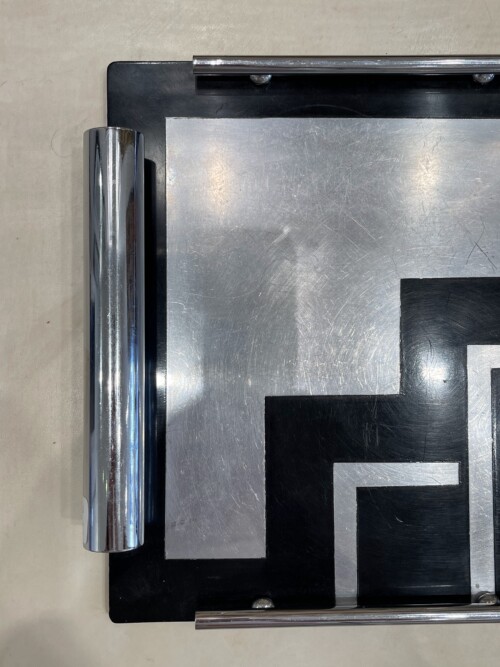
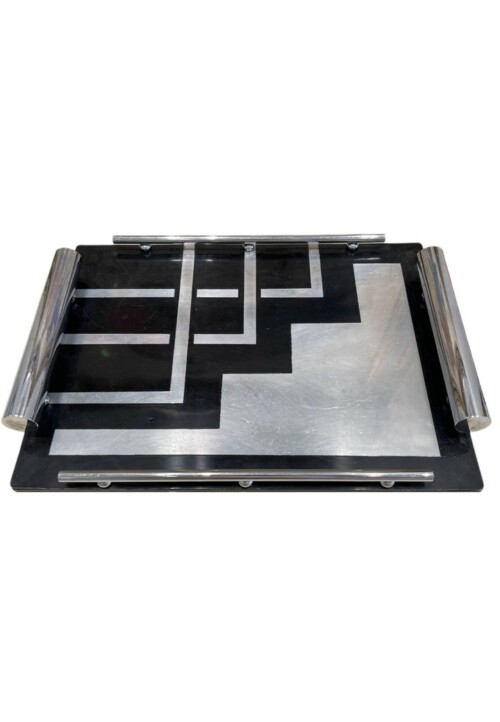 Ce plateau rectangulaire daté des années 1930 est typique du Bauhaus. Sa composition est marquée par une asymétrie du décor comprenant cependant des motifs géométriques réguliers, des lignes pures et un détachement face à l'ornement caractéristique du goût du Bauhaus. Le plateau est en bois laqué noir incrusté de lames d'aluminium et les prises sont en métal chromé. Il présente quelques piqures, rayures et sauts de laque. Hauteur : 5.5 cm Longueur : 40.5 cm Largeur : 30cm
Ce plateau rectangulaire daté des années 1930 est typique du Bauhaus. Sa composition est marquée par une asymétrie du décor comprenant cependant des motifs géométriques réguliers, des lignes pures et un détachement face à l'ornement caractéristique du goût du Bauhaus. Le plateau est en bois laqué noir incrusté de lames d'aluminium et les prises sont en métal chromé. Il présente quelques piqures, rayures et sauts de laque. Hauteur : 5.5 cm Longueur : 40.5 cm Largeur : 30cm
Stunning rectangular tray adorned with geometric patterns in typical Bauhaus style. The pattern is asymmetrical with regular motifs, the lines are clean and simples. This tray dates back to the 1930s. The tray is made of black lacquered wood, inlaid with aluminium strips and the handles are made in chromed metal. It shows some minor pittings and scratches. Height : 2.17 inches/5.5 cm Length : 15.95 inches/40.5 cm Width : 11.82 inches/30cm
